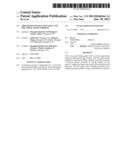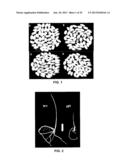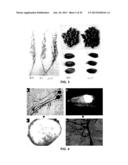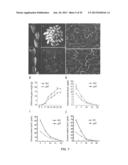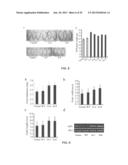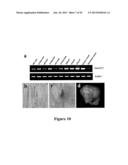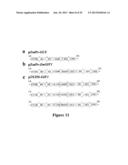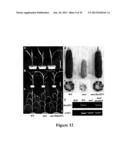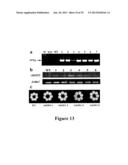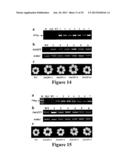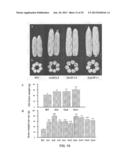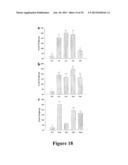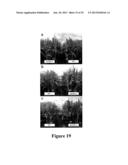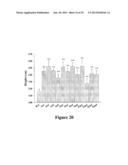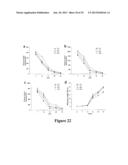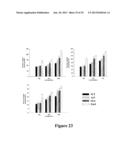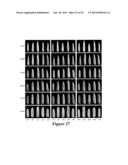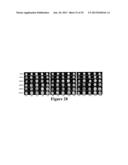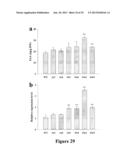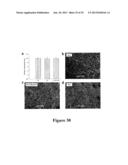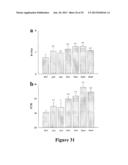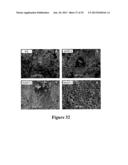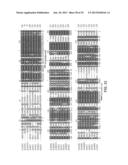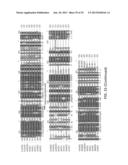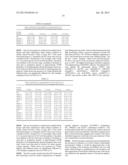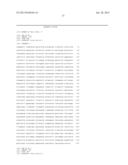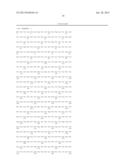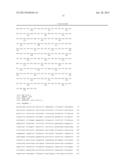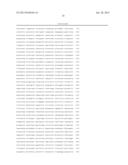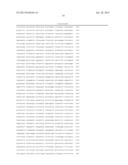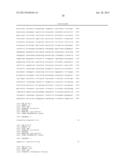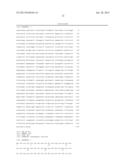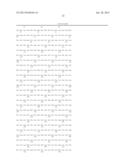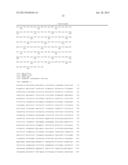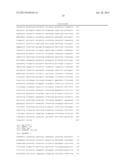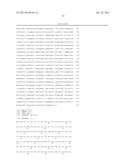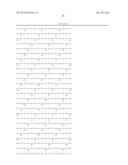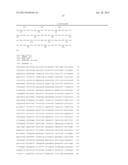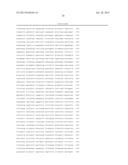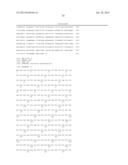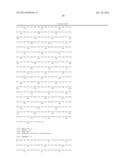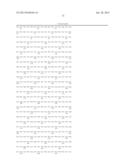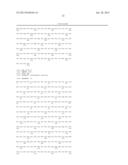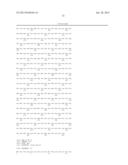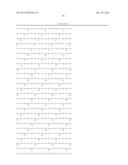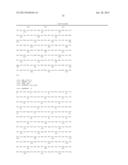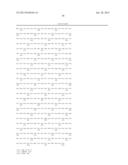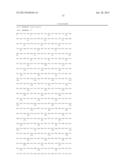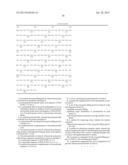Patent application title: CROP GRAIN FILLING GENE (GIF1) AND THE APPLICATIONS THEREOF
Inventors:
Zuhua He (Shanghai, CN)
Shanghai Institutes For Biological Science, Chines (Shanghai, CN)
Hongxia Zhang (Shanghai, CN)
Bei Li (Shanghai, CN)
Hua Liu (Shanghai, CN)
Assignees:
Shanghai Institutes for Biological Sciences, Chinese Academy of Sciences
IPC8 Class: AC12N1582FI
USPC Class:
800290
Class name: Multicellular living organisms and unmodified parts thereof and related processes method of introducing a polynucleotide molecule into or rearrangement of genetic material within a plant or plant part the polynucleotide alters plant part growth (e.g., stem or tuber length, etc.)
Publication date: 2013-06-20
Patent application number: 20130160164
Abstract:
Novel crop grain filling genes (GIF1) and the applications thereof are
presented in the invention. The GIF1 genes can be applied to control
grain filling, enhance crop yield or quality, or improve disease
resistance or storage stability of crop grains. A method for improving
crops is also presented in the invention. The GIF1 genes shows valuable
potentials in controlling crop yield, quality, storage, and resistance to
diseases.Claims:
1. An isolated crop grain filling protein, wherein the protein is
selected from the group consisting of: (a) a polypeptide having the amino
acid sequence of SEQ ID NO: 7 or 10; or (b) a polypeptide derived from
the polypeptide of (a) by substitution, deletion or addition of one or
several amino acid residues in the amino acid sequence of SEQ ID NO: 7 or
10 and having the activity of promoting crop grain filling.
2. An isolated polynucleotide, wherein the polynucleotide is selected from the group consisting of: (i) a polynucleotide encoding the crop grain filling protein of claim 1; or (ii) a polynucleotide complementary to the polynucleotide of (i).
3. The polynucleotide of claim 2, wherein the polynucleotide encodes a polypeptide having the amino acid sequence of SEQ ID NO: 7 or 10.
4. The polynucleotide of claim 2, wherein the polynucleotide having a sequence selected from a group consisting of: (1) a nucleotide sequence of SEQ ID NO: 6 or 9; (2) a nucleotide sequence of SEQ ID NO: 8 or 11; or (3) a nucleotide sequence complementary to the nucleotide sequence of (1) or (2).
5. A vector containing the polynucleotide of claim 2.
6. A genetically engineered host cell containing the vector of claim 5.
7. A use of the crop grain filling protein of claim 1 or the encoding gene thereof in: regulating crop grain filling; regulating sugar metabolism or accumulation in crop grains; or improving the disease resistance or storage stability of crop grains.
8. A method for improving crops, wherein the method comprises: enhancing the expression of the crop grain filling gene in the crop.
9. A method for preparing transgenic plants, wherein the method comprises the step of: introducing the polynucleotide of claim 2 into plant cells or tissues, culturing the plant cells or tissues, and regenerating them to plants.
10. An agonist or antagonist for the crop grain filling protein of claim 1 or the encoding gene thereof.
11. A genetically engineered host cell is integrated in its genome with the polynucleotide of claim 2.
Description:
CROSS REFERENCE TO RELATED APPLICATIONS
[0001] This is a Continuation in Part application of application Ser. No. 12/312,235, filed on Apr. 30, 2009, which is a national phase application of PCT/CN2007/070984, filed on Oct. 30, 2007, which claims priority of Chinese Application No. 200610117721.6, filed on Oct. 30, 2006. This application claims the benefits and priority of these prior applications and incorporates these prior applications by reference in their entireties.
TECHNICAL FIELD
[0002] This invention relates to gene technology and botany field; particularly, relates to a novel crop grain filling gene, GIF1 (Grain Incomplete Filling 1) gene, and its applications.
BACKGROUND ART
[0003] Currently, investigations concerning the improvement of crop yield are mainly focused on the following aspects: 1. increasing crop sources, viz. improving crop photosynthesis; 2. elevating the sink volume; and, 3. enhancing the transport ability of photosynthate from source to sink. Among them, elevation in the sink volume and enhancement of transport ability of photosynthate from source to sink are effective breeding approaches.
[0004] Several approaches have been adopted to enhance crop yield and modify the crops. However, there still lacks effective means. With respect to rice, the major cereal crops of China, grain incomplete filling is present in many high yield varieties, especially in super hybrid rice and rice varieties with large ear and large grain, and greatly affects the improvement in the rice yield. In addition to rice, wheat and maize (Zea mays) have been grown worldwide as an important grain crops. Together, they constitute the world's major staple food crops. Grain incomplete filling also impacts wheat, maize, and other crops.
[0005] Therefore, it is desirable to search for an effective approach in the field to solve the problem of grain incomplete filling, thus further modifying the crops and enhancing the crop yield as well as crop quality.
SUMMARY OF THE INVENTION
[0006] The object of the present invention is to provide a novel crop grain filling gene, GIF1 (Grain Incomplete Filling 1) gene, and its applications.
[0007] In the first aspect of the invention, an isolated crop grain filling protein is presented, wherein the protein is selected from a group consisting of:
[0008] (a) a polypeptide having the amino acid sequence of SEQ ID NO: 2; or
[0009] (b) a polypeptide derived from the polypeptide of (a) with one or more amino acid residues in SEQ ID NO:2 being substituted, deleted or added, and capable of promoting grain filling.
[0010] In the second aspect of the invention, an isolated polynucleotide is presented, wherein the polynucleotide is selected from:
[0011] (i) a polynucleotide that encodes the grain filling protein; or
[0012] (ii) a polynucleotide complementary with the polynucleotide of (i).
[0013] In another preferred embodiment, the polynucleotide encodes the polypeptide having SEQ ID NO: 2.
[0014] In another preferred embodiment, the sequence of the polynucleotide is selected from:
[0015] (1) a nucleotide sequence of SEQ ID NO: 1;
[0016] (2) a nucleotide sequence of SEQ ID NO: 3; or
[0017] (3) a nucleotide sequence complementary to any one of the nucleotide sequence of (1) or (2).
[0018] In the third aspect of the invention, a vector is presented, wherein the vector contains said polynucleotide.
[0019] In the fourth aspect of the invention, a genetically engineered host cell is presented, wherein the cell contains said vector or the cell genome is integrated with said polynucleotide.
[0020] In the fifth aspect of the invention, a use of the grain filling protein or its encoding gene is presented, which comprises:
[0021] regulating grain filling (preferably facilitating crop grain filling);
[0022] regulating sugar metabolism or accumulation involved in crop grains; or
[0023] improving the disease tolerance and storage stability of crop grains.
[0024] In the sixth aspect of the invention, a method for modifying crops was presented, which comprises: increasing the expression of said grain filling gene in the crop.
[0025] In the seventh aspect of the invention, a method for preparing transgenic plants was presented, which comprises the step of: introducing the polynucleotide of the present application into plant cells or tissues, culturing said plant cells or tissues, and regenerating said plant cells or tissues to plants.
[0026] In another preferred embodiment of the invention, the method comprises the steps of:
[0027] (a) providing Agrobacterium tumefaciens carrying the expression vector, wherein the expression vector comprises the encoding gene for the grain filling protein;
[0028] (b) contacting crop cells, tissues or organs with the Agrobacterium tumefaciens in step (a) so as to introduce the DNA sequence encoding grain filling protein into said crop cells, tissues or organs, and integrate the same into the crop chromosome;
[0029] (c) regenerating the crop cells, tissues or organs introduced with the DNA sequence encoding grain filling protein to crop plants.
[0030] In the eighth aspect of the invention, an agonist or antagonist for the grain filling protein or its encoding gene is presented.
[0031] Other aspects of the invention will be readily apparent to those skilled in the art based on the contents contained in the invention.
BRIEF DESCRIPTION OF THE FIGURES
[0032] FIG. 1 shows the effect of GIF1 gene on rice quality, wherein FIG. 1A refers to brown rice grains of wild-type plant; FIG. 1B refers to brown rice grains of mutant plant; FIG. 1C refers to polished rice grains of wild-type plant; and FIG. 1D refers to polished rice grains of mutant plant.
[0033] FIG. 2 shows the effect of GIF1 gene on seed vigor, wherein WT (left) refers to ZH11 wild-type plant and gif1 (right) refers to ZH11 mutant plant.
[0034] FIG. 3 shows the effect of GIF gene on the crop ear, wherein WT refers to the ear of ZH11 wild-type plant; F1 refers to the ear of the first filial generation of ZH11 wild-type and ZH11 mutant plants; gif1 refers to the ear of ZH11 mutant plant.
[0035] FIG. 4 shows the typical storage disease bacteria isolated from the seeds of g111 mutant plant, wherein FIG. 4A and FIG. 4C (magnification of FIG. 4A) refer to the isolated Rhizopus sp.; FIG. 4B and FIG. 4D (magnification of FIG. 4B) refer to the isolated Alternaria sp.
[0036] FIG. 5 shows the tissue specificity of GIF1, wherein Fig. A represents root; Fig. B represents internode; Fig. C represents stretched-out (elongated) internode; Fig. D represents the 2nd day; Fig. E represents the 4th day; Fig. F represents the 6th day; Fig. G represents the 10th day; Fig. H represents the 15th day; FIG. 1 represents the 25th day; Fig. J represents glume; Fig. K represents cross section of seed on the 10th day; Fig. L represents the expression of GIF1 gene in mutant and wild-type plants; Fig. M represents the expression of GIFT gene in seedlings, leaves, roots, internodes, and ears (wherein LS refers to rice seedlings, L to rice leaves, R to rice roots, I to rice internodes, and P to ears); Fig. N represents the expression of GIF1 gene at different time intervals post to flowering; and DAF (Day After Flowering) refers to the number of days post to flowering.
[0037] FIG. 6 shows the effect of GIF1 gene on the grain sugar metabolism and accumulation, wherein total starch includes amylose and amylopectin.
[0038] FIG. 7 shows grain-filling and sugar content of wild-type or gif1 mutant grains. (a) and (b) gif1 mutant grains (a) and wild-type grains (b) on 25DAF. (c) and (d) polished rice grains of gif1 mutant rice (c) and wild-type rice (d). (e) and (f) SEM analysis of gif1 mutant grains (e) and wild-type grains (f). Results show abnormal development and loosening of gif1 mutant starch granules. (g) grain filling process (1000-brown rice weight) of wild-type or gif1 mutant rice. (h)-(j) sucrose, sugar, and fructose contents in wild-type or gif1 mutant grains, respectively.
[0039] FIG. 8 shows the enlarged size of the grains of transgenic rice overexpressing GIF1. (a) Two transgenic rice lines, G-2 and G-8, overexpressing GIF1, are compared to control wild-type rice in terms of grain size. Results show that the transgenic rice lines possess larger grains. (b) comparison of grain weight among five transgenic rice lines overexpressing GIF1 (G-2, G-8, G-10, G11, and G-16), wild-type rice (WT), empty vector transformed rice (Vector). Statistically difference: *P<0.05.
[0040] FIG. 9 illustrates that grains of transgenic rice with additional GIF1 show an increase in thickness, width as well as length, and enhanced expression of GIF1. (a-c) two transgenic rice lines of G-2 and G-8 overexpressing GIF1 are compared with wild-type rice (WT) and empty vector transformed rice (Vector) in terms of grain thickness (a), width (b), and length (c). Results confirm that transgenic rice lines of G-2 and G-8 that overexpress GIF1 possess larger grains. (d) two transgenic rice lines of G-2 and G-8 overexpressing GIF1 are compared with wild-type rice (WT) and empty vector transformed rice (Vector) in terms of gene expression level of GIF1 using RT-PCR. Results illustrate that transgenic rice lines of G-2 and G-8 that overexpress GIF1 show higher expression of the GIF1 gene. Ubi-1 refers to the loading control.
[0041] FIG. 10 shows ZmGIF1 gene expression and GUS staining analyses. (a) RT-PCR analyses of ZinGIF1 transcripts in different tissues of wild type maize (Ye478). cDNA derived from the indicated tissues was used as template for PCR with the gene specific primers. The Actin1 gene was employed as an internal control. (b) GUS activity in the growing root (T2). (c) GUS activity in shoot tip (T2). (d) GUS activity in the kernel at 21 DAP (T3). GUS activity was predominantly restricted to the basal endosperm transfer layer (BETL).
[0042] FIG. 11 shows Structure of plant expression vectors used in this study. (a) Schematic structures of the T-DNA region of plant expression vector for GUS activity analysis. The β-glucuronidase (GUS) encoding gene is driven by the ZmGIF1 promoter. (b) Schematic structures of the T-DNA region of plant expression vector for mn1 complementation. ZmGIF1 is driven by its own promoter. (c) Schematic representation of T-DNA regions in the plant expression vectors used for maize transformation. LB, T-DNA left border repeat; 35S, CaMV35S promoter; GUS, β-glucuronidase gene; NOS, nopaline synthase gene terminator; OCS, octopine synthase gene terminator; bar, phosphinothricin N-acetyltransferase gene; RB, T-DNA right border repeat.
[0043] FIG. 12 shows Functional complementation of ZmGIF1 mutant (mn1) by ZmGIF1. (a-c) Phenotypes of wild type (W22), mn1 and its complementary line (T2) mn1/ZmGIF1. Plants were grown in the greenhouse. Photos were taken at four-leaf, seven-leaf and flowering stage, respectively. Scale bar=10 cm. (d, e) Corn cobs and kernels (T3) harvested from wild type (WT), mn1 and mn1/ZinGIF1. (f) RT-PCR analyses. Total RNA was extracted from seeds of W22, mn1 and its complementary line mn1/ZmGIF1 (T3) at 12DAP. RT-PCR analyses were performed with ZmGIF1 gene specific primers. The analysis was repeated twice with similar results. The housekeeping gene Actin1 was used as an internal control.
[0044] FIG. 13 shows Confirmation of transgene integration and expression by PCR, RT-PCR and comparison of kernel sizes. Genomic DNA or total RNA was isolated from leaves of wild type Ye478 (WT) and transgenic (T3) plants constitutively expressing AtGIF1 (lines 1-7). Plants were grown to the five-leaf stage in the greenhouse. (a) PCR analysis using AtGIF1-specific primers. A 697 bp PCR product was detected in all transgenic lines. M, γ-EcoT14 I digest DNA markers; H2O, PCR product with double distilled water as template; WT, PCR product with wild type plant genomic DNA as template; 1-7, PCR products with transgenic plant genomic DNA as template. (b) RT-PCR analysis. RT-PCR was performed using AtGIF1-specific primers or Actin1-specific primers. The Actin1 gene was used as an internal control. (c) Kernels of Ye478 (WT) and transgenic maize plants (T4).
[0045] FIG. 14 shows Confirmation of transgene integration and expression by PCR, RT-PCR and comparison of kernel sizes. Genomic DNA or total RNA was isolated from leaves of wild type Ye478 (WT) and transgenic (T3) plants constitutively expressing OsGIF1 (lines 1-7). Plants were grown to the five-leaf stage in the greenhouse. (a) PCR analysis of wild type and different transgenic lines of Ye478 using OsGIF1-specific primers. An 827 bp PCR product was detected in all transgenic lines. M, γ-EcoT14 I digest DNA markers; H2O, PCR product with double distilled water as template; WT, PCR product with wild type plant genomic DNA as template; 1-7, PCR products with transgenic plant genomic DNA as template. (b) RT-PCR analysis. RT-PCR was performed using OsGIF1-specific primers or Actin1-specific primers. The Actin1 gene was used as an internal control. (c) Kernels of Ye478 (WT) and transgenic maize plants (T4).
[0046] FIG. 15 shows Confirmation of transgene integration and expression by PCR, RT-PCR and comparison of kernel sizes. Genomic DNA or total RNA was isolated from leaves of wild type Ye478 (WT) and transgenic (T3) plants constitutively expressing ZmGIF1 (lines 1-7). Plants were grown to the five-leaf stage in the greenhouse. (a) PCR analysis of wild type and different transgenic lines of Ye478 using ZmGIF1-specific primers. A 779 bp PCR product was detected in all transgenic lines. M, γ-EcoT14 I digest DNA markers; H2O, PCR product with double distilled water as template; WT, PCR product with wild type plant genomic DNA as template; 1-7, PCR products with transgenic plant genomic DNA as template. (b) RT-PCR analysis. RT-PCR was performed using ZmFIF1-specific primers or Actin1-specific primers. The Actin1 gene was used as an internal control. (c) Kernels of Ye478 (WT) and transgenic maize plants (T4).
[0047] FIG. 16 shows Corn cobs, kernel and Grain weights of wild type Ye478 and transgenic lines (T4) constitutively expressing AtGIF1, OsGIF1 or ZmGIF1. (a) Corn cobs of Ye478 and different transgenic lines. Scale bar=2 cm. (b) Kernels of Ye478 and different transgenic lines. Scale bar=1 cm). (c) One-hundred grain weights of Ye478 and different transgenic lines. (d) Ear grain weights of Ye478 and different transgenic lines. WT, wild type Ye478; At1, At3 and At4, transgenic lines AtGIF1-1, AtGIF1-3 and AtGIF1-4; Os1, Os3 and Os4, transgenic lines OstGIF1-1, OsGIF1-3 and OsGIF1-4; Zm1, Zm3 and Zm4, transgenic lines ZmGIF1-1, ZmGIF1-3 and ZmGIF1-4. Data are shown as means±s.e.m. Asterisks indicate a significant difference between transgenic and WT plants under the same conditions at *0.01<P<0.05 and **P<0.01 using the Student's t-test (n=3).
[0048] FIG. 17 shows Growth phenotypes of wild type Ye478 (WT) and transgenic lines (T4) constitutively expressing AtGIF1, OsGIF1 and ZmGIF1. Scale bar=10 cm. Three-month-old plants at 13-leaf stage grown in the greenhouse are shown. (a) WT and different transgenic lines constitutively expressing AtGIF1. (b) WT and different transgenic lines constitutively expressing OsGIF1. (c) WT and different transgenic lines constitutively expressing ZmGIFJ.
[0049] FIG. 18 shows Fresh weights of aerial parts of wild type Ye478 (WT) and transgenic lines (T4) constitutively expressing AtGIF1, OsGIF1 and ZmGIF1. The aerial parts of three-month-old plants at 13-leaf stage grown in the greenhouse are harvested for biomass analyses. (a) WT and different transgenic lines constitutively expressing AtGIF1. (b) WT and different transgenic lines constitutively expressing OsGIF1. (c) WT and different transgenie lines constitutively expressing ZmGIF1. WT, wild type Ye478; At1, At3, At4 and At5, transgenic lines AtGIF1-1, AtGIF1-3, AtGIF1-4 and AtGIF1-5; Os1, Os3, Os4 and Os6, transgenic lines OstGIF1-1, OsGIF1-3, OsGIF1-4 and OsGIF1-6; Zm1, Zm2, Zm3 and Zm4, transgenic lines ZmGIF1-1, ZmGIF1-2, ZmGIF1-3 and ZmGIF1-4. Data are shown as means±s.e.m. Asterisks indicate a significant difference between transgenic and WT plants under the same conditions at **P<0.01 using the Student's t-test (n=3).
[0050] FIG. 19 shows Phenotypes of wild type Ye478 (WT) and transgenic lines (T4) constitutively expressing AtGIF1, OsGIF1 or ZmGIF1 at flower stage grown on Nanbin Farm in Hainan province, China. Seeds were sown on Nov. 25, 2011. Scale bar=10 cm. (a) WT and transgenic line AtGIF1-4. (b) WT and transgenic line OsGIF1-1. (c) WT and transgenic line ZmGIF1-1.
[0051] FIG. 20 shows Plant heights of wild type Ye478 (WT) and transgenic lines (T4) constitutively expressing AtGIF1, OsGIF1 or ZmGIF1. Seeds were sown in Hainan province, China on Nov. 25, 2011. The aerial parts of shoots were harvested at maturity. WT, wild type Ye478; At1, At3, At4 and At5, trans genic lines AtGIF1-1, AtGIF1-3, AtGIF1-4 and AtGIF1-5; Os1, Os3, Os4 and Os6, transgenic lines OstGIF1-1, OsGIF1-3, OsGIF1-4 and OsGIF1-6; Zm1, Zm2, Zm3 and Zm4, transgenic lines ZmGIF1-1, ZmGIF1-2, ZmGIF1-3 and ZmGIF1-4. Data are shown as means±s.e.m. Asterisks indicate a significant difference between transgenic and WT plants under the same conditions at **P<0.01 using the Student's t-test (n=3).
[0052] FIG. 21 shows Cell wall invertase activity analyses. Cell wall invertase activities in wild type Ye478 (WT) and different transgenic lines constitutively expressing AtGIF1, OsGIF1 or ZmGIF1 were measured. (a-c) Cell wall invertase activities in leaves of WT and transgenic (T3) lines grown in the greenhouse at 13-leaf stage. (d-f) Cell wall invertase activities in seeds of field grown WT and transgenic (T4) lines at 12 DAP. Data are shown as means±s.e.m. Asterisks indicate a significant difference between transgenic and WT plants under the same conditions at *0.01<P<0.05 and **P<0.01 using the Student's t-test (n=3). WT, wild type Ye478; At1, At3, At4 and At5, transgenic lines AtGIF1-1, AtGIF1-3, AtGIF1-4 and AtGIF1-5; Os1, Os3, Os4 and Os6, transgenic lines OstGIF1-1, OsGIF1-3, OsGIF1-4 and OsGIF1-6; Zm1, Zm2, Zm3 and Zm4, transgenic lines ZmGIF1-1, ZmGIF1-2, ZmGIF1-3 and ZmGIF1-4.
[0053] FIG. 22 shows Sugar content and grain-filling of wild type Ye478 (WT) and different transgenic lines constitutively expressing AtGIF1, OsGIF1 or ZmGIF1. Seeds of WT and different transgenic (T4) lines were sown in November, 2011 on Nanbin Farm, Hainan province, China. Bars represent s.d. of three replications. (a-c) Glucose, fructose and sucrose contents of WT and transgenic kernels (T5). (d) Grain-filling process (weight in grams of 100 dry kernels) of WT and transgenic maize (T5). WT, wild type Ye478; At3, transgenic line AtGIF1-3; Os4, transgenic line OsGIF1-4; Zm1, transgenic line ZmGIF1-1.
[0054] FIG. 23 shows Sugar content in leaves of wild type Ye478 (WT) and different transgenic lines constitutively expressing AIGIF1, OsGIF1 or ZmGIF1. WT and transgenic (T4) lines were grown in the greenhouse and sugar contents in leaves at different positions were measured. WT, wild-type Ye478; At3, transgenic line AtGIF1-3; Os4, transgenic line OsGIF1-4; Zm1, transgenic line ZmGIF1-1. Data are shown as means±s.e.m. Asterisks indicate a significant difference between transgenic and WT plants under the same conditions at *0.01<P<0.05 and **P<0.01 using the Student's t-test (n=3).
[0055] FIG. 24 shows Corn cobs size comparisons of wild type Ye478 (WT) and different transgenic lines (T5) constitutively expressing AtGIF1, OsGIF1 or ZmGIF1. Seeds of WT and different transgenic (T4) lines were sown on Nov. 25, 2011 on Nanbin Farm, Hainan province, China. Cobs at different growth stages were shown. WT, wild type Ye478; At1, At3, At4 and At5, transgenic lines AtGIF1-1, AtGIF1-3, AtGIF1-4 and AtGIF1-5; Os1, Os3, Os4 and Os6, transgenic lines OstGIF1-1, OsGIF1-3, OsGIF1-4 and OsGIF1-6; Zm1, Zm2, Zm3 and Zm4, transgenic lines ZmGIF1-1, ZmGIF1-2, ZmGIF1-3 and ZmGIF1-4. Scale bar=2 cm.
[0056] FIG. 25 shows Cross-section views of corn cobs of wild type Ye478 (WT) and different transgenic lines (T5) constitutively expressing AtGIF1, OsGIF1 or ZmGIF1. Seeds of WT and different transgenic (T4) lines were sown on Nov. 25, 2011 on Nanbin Farm, Hainan province, China. Cross-sections of corn cobs at different growth stages were shown. WT, wild type Ye478; At1, At3, At4 and At5, transgenic lines AtGIF1-1, AtGIF1-3, AtGIF1-4 and AtGIF1-5; Os1, Os3, Os4 and Os6, transgenic lines OstGIF1-1, OsGIF1-3, OsGIF1-4 and OsGIF1-6; Zm1, Zm2, Zm3 and Zm4, transgenic lines ZmGIF1-1, ZmGIF1-2, ZmGIF1-3 and ZmGIF1-4. Scale bar=2 cm.
[0057] FIG. 26 shows Corn cob and kernel of wild type Ye478 and transgenic lines (T6) constitutively expressing AtGIF1, OsGIF1 or ZmGIF1. (a) Corn cobs of Ye478 and different transgenic lines. (b) Kernels of Ye478 and different transgenic lines. WT, wild type Ye478; At3 and At4, transgenic lines AtGIF1-3 and AtGIF1-4; Os1 and Os4, transgenic lines OstGIF1-1 and OsGIF1-4; Zm1 and Zm3, transgenic lines ZmGIF1-1 and ZmGIF1-3. Scale bar=2 cm.
[0058] FIG. 27 shows Corn cobs size comparisons of wild type Ye478 (WT) and different transgenic lines (T6) constitutively expressing AtGIF1, OsGIF1 or ZmGIF1. Seeds of WT and different transgenic (T4) lines were sown in June, 2012 in Zhangye, Gansu province, China. Cobs at different growth stages were shown. WT, wild type Ye478; At1, At3, At4 and At5, transgenic lines AtGIF1-1, AtGIF1-3, AtGIF1-4 and AtGIF1-5; Os1, Os3, Os4 and Os6, transgenic lines OstGIF1-1, OsGIF1-3, OsGIF1-4 and OsGIF1-6; Zm1, Zm2, Zm3 and Zm4, transgenic lines ZmGIF1-1, ZmGIF1-2, ZmGIF1-3 and ZmGIF1-4. Scale bar=2 cm.
[0059] FIG. 28 shows Cross-section views of corn cobs of wild type Ye478 (WT) and different transgenic lines (T6) constitutively expressing AtGIF1, OsGIF1 or ZmGIF1. Seeds of WT and different transgenic (T4) lines were sown in June, 2012 in Zhangye, Gansu province, China. Cross-sections of corn cobs at different growth stages were shown. WT, wild type Ye478; At1, At3, At4 and At5, transgenic lines AtGIF1-1, AtGIF1-3, AtGIF1-4 and AtGIF1-5; Os1, Os3, Os4 and Os6, transgenic lines OstGIF1-1, OsGIF1-3, OsGIF1-4 and OsGIF1-6; Zm1, Zm2, Zm3 and Zm4, transgenic lines ZmGIF1-1, ZmGIF1-2, ZmGIF1-3 and ZmGIF1-4. Scale bar 2 cm.
[0060] FIG. 29 shows IAA content and real time PCR analyses. Wild type Ye478 (WT) and different transgenic (T4) lines constitutively expressing AIGIF1, OsGIF1 or ZmGIF1 were grown in the greenhouse. The top two leaves from 13-leaf stage plants were used for the analyses. (a) IAA content. (b) Relative expression level (2.sup.-ΔΔct) of putative IAA biosynthetic gene ZmTAR1. Data are shown as means±s.e.m. Asterisks indicate a significant difference between transgenic and WT plants under the same conditions at *0.01<P<0.05 and **P<0.01 using the Student's t-test (n=3).
[0061] FIG. 30 shows Real time PCR and scanning electron microscope analyses. (a) Quantitative real-time PCR analyses of the putative IAA biosynthetic gene ZmTAR1 transcript levels (2.sup.-ΔΔct). Total RNA was extracted from leaves of W22, mn1 and its complementary line mn1/ZmGIF1 (T2) plants grown in the greenhouse at five-leaf stage. Real-time PCR analyses were performed with ZmTAR1 gene specific primers. The relative expression of ZmTAR1 gene was double-normalized using the housekeeping gene Actin1. Data represents the average of three independent experiments±SD. (b-d) Scanning electron microscope observation. Mature dry seeds were used. Magnification, ×500. Scale bar=50 μm. WT, Wildtype W22; mn1, mn1 mutant; mn1/ZmGIF1, mn1 transgenic line complemented with ZmGIF1 driven by its own promoter (T3).
[0062] FIG. 31 shows Maximum quantum efficiency (Fv/Fm) and photosynthetic electron transport rate (ETR) analyses. Wild type Ye478 (WT) and different transgenic (T4) lines constitutively expressing AtGIF1, OsGIF1 or ZmGIF1 were grown in the greenhouse to the 13-leaf stage. Photosynthesis activities were measured on the 10th fully-expanded leaves using Junior-PAM after a 5 min dark adaptation. Data are shown as means±s.e.m. Asterisks indicate a significant difference between transgenic and WT plants under the same conditions at *0.01<P<0.05 and **P<0.01 using the Student's t-test (n=3). (a) Fv/Fm. (b) ETR.
[0063] FIG. 32 shows Scanning electron microscope analyses. Mature seeds of wild type Ye478 and transgenic lines (T4) constitutively expressing AtGIF1, OsGIF1 and ZmGIF1 were used for scanning electron microscope observation. Magnification, ×500. Scale bar=50 μm. (a) Wild type Ye478. (b) AtGIF1-3. (c) OsGIF1-4. (d) ZmGIF1-1.
[0064] FIG. 33 shows Sequence alignments of GIF1 with homologous proteins from different plants. The BLAST search program (http://www.ncbi.nlm.nih.gov/BLAST/) was used to look for invertase sequences homologous to GIF1. The highest homologous invertase sequences were aligned using a GENEDOC software. The aligned invertases include the functionally known OsGIF1 (rice ADE60571.1), OsCIN1 (rice ADE60654.1), PtINCW1 (PaxgINV1 ABY81288.1), PtINCW2 (PaxgINV2 ABY81289.1) and ZmCWIN1 (maize AAD02511.1), ZmGIF1 (also known as Mn1; NM--001112126), and functionally unknown invertases ATCWINV2 (Arabidopsis NP--190828.2) and AtGIF1 (Arabidopsis NP--566464.1). The β-fructosidase motif, the Cys catalysis site, and the conserved glycosylation motif are indicated.
DETAILED DESCRIPTION
[0065] Embodiments of the invention relate to grain incomplete filling 1 (GIF1) proteins and genes and their uses in improving grain filling, seed sizes, and grain yields in crops. GIF1 genes encode cell wall invertases in various plants. Embodiments of the invention, for example, relate to the use of GIF1 proteins from Arabidopsis (AtGIF1, or ATCWINV1), rice (OsGIF1, or OsCIN2) and maize (ZmGIF1, ZmCWIN2; also know as Mn1) in the improvement of grain fillings, seed sizes and grain yields of these plants and similar cropts.
[0066] In most agriculturally important plants, carbohydrate is distributed through the sieve element system to the sink organs in the form of sucrose, the end product of photosynthesis in source organs. In the sink organs, sucrose is cleaved, by invertase or sucrose synthetase, to monomers that are used to synthesize carbohydrate polymers (e.g., starch), which are the storage forms of photosynthesis products.
[0067] The inventors of the present invention discovered that GIF1 genes can control crop grain fillings. Non-expression or lowered expression of these genes would significantly interfere with crop grain fillings, reduce seed weights, and crop yields. Comparatively, enhanced expression of these genes could facilitate crop grain fillings and increase seed weights and crop yields. These genes were cloned and named GIF1 genes (Grain Incomplete Filling 1). Investigations confirmed that normal expression of GIF1 in wild-type plants led to normal growth of crop grains, while mutation of GIF1 causing nonexpression of the GIF1 proteins would result in poor crop qualities, low seed vigor, and poor resistance towards storage diseases. Importantly, these features were notably improved in transgenic crops with enhanced expression of GIF1 proteins. Based on the aforementioned findings, the current invention has been completed.
[0068] As used herein, "crop" refers to, but not limited to, Graminae, Brassicaceae (Cruciferae), Fabaceae (Leguminosae), Malvaceae, Chenopodiacea, Asteraceae, Myyrtaceae, Salicaceae, and xylophyta, and the like. Preferably, crops includes, but not limited to, rice, wheat, barley, maize, broomcorn, soybean, cotton, canola, sugar beet, alfalfa, rye, sorghum, sugarcane, sunflower, oilseed rape (rapeseed), vegetables, Eucalyptus, poplar, etc.
[0069] As used herein, the term "isolated" refers to a substance which has been isolated from the original environment. For naturally occurring substance, the original environment is the natural environment. e.g., the polynucleotide and polypeptide in a naturally occurring state in the viable cells are not isolated or purified. However, if the same polynucleotide and polypeptide have been isolated from other components naturally accompanying them, they are isolated or purified.
[0070] As used herein, "GIF1" refers to grain incomplete filling 1. Analogs of these genes are found in common crops. "GIF1 gene" and "GIF1 protein" refer to the corresponding gene and protein, respectively. They may be referred to as "GIF1" without regard to the source. Alternatively, they may be referred to as, for example, AtGIF1, OsGIF1, or ZmGIF1, based on their sources from Arabidopsis thaliana, Oryza sativa (rice), and Zea mays (maize), respectively.
[0071] As used herein, "isolated GIF1 protein" or "isolated GIF1 polypeptide" refers to an GIF1 protein that does not exist in the natural environment, which includes a completely purified GIF1 protein. Substantively purified GIF1 protein contains almost no naturally relevant proteins, lipids, saccharides, or other substances. The GIF1 proteins could be purified by those skilled in the art using standard protein purification techniques. A purified polypeptide forms a single main band on a non-reductive PAGE gel.
[0072] Polypeptides of the present invention can be recombinant polypeptides, natural polypeptides, or synthetic polypeptides, preferably recombinant polypeptides. Polypeptides of the present invention may be purified natural products or chemically synthetic products. Alternatively, they may be produced from prokaryotic or eukaryotic hosts, such as bacteria, yeast, higher plant, insect, and mammalian cells, using recombinant techniques. According to the hosts used in the recombinant production, the polypeptides may be glycosylated or non-glycosylated. Polypeptides of the present invention could bear or not bear the initial methionine residues.
[0073] The invention further comprises fragments, derivatives or analogues of GIF1. As used herein, the term "fragment," "derivative" or "analogue" mean a polypeptide that essentially retains the same biological functions or activity of GIF1 protein. Based on the following descriptions and examples, one having ordinary skill in the art could easily determine whether the polypeptides have the same biological functions or activities as the GIF1 proteins. A polypeptide fragment, derivative or analogue of the present invention could be (i) a polypeptide with one or more amino acid residues deleted or inserted, or one or more conserved or non-conserved amino acid residue (preferably conserved amino acid residue) being substituted, wherein the substituted amino acid residues could be encoded or not encoded by the genetic codes; or (ii) a polypeptide with one or more amino acid residues including substituted groups; or (iii) one in which a mature polypeptide is fused with another compound, such as a compound to increase the half-life of the polypeptide (for example, polyethylene glycol), or (iv) one in which the additional amino acids, such as a leader or secretary sequence or a sequence used for purifying polypeptide or pro-protein, are fused to the polypeptide. Such fragments, derivatives and analogs are known to the artisans based on the teachings herein.
[0074] As used herein, the term "OsGIF1 protein" refers to a polypeptide with the amino acid sequence of SEQ ID NO: 2 and OsGIF1 protein activity. The term "AtGIF1 protein" refers to a polypeptide with the amino acid sequence of SEQ ID NO: 7 and AtGIF1 protein activity. the term "ZmGIF1 protein" refers to a polypeptide with the amino acid sequence of SEQ ID NO: 10 and ZmGIF1 protein activity. The terms also comprise the variants which have the same functions of these GIF1 proteins and have the amino acid sequences of SEQ ID NO: 2, SEQ ID NO: 7, or SEQ ID NO: 10. The variants include, but are not limited to, deletions, insertions and/or substitutions of one or more (typically 1-200, preferably 1-180, preferably 1-150, preferably 1-120, preferably 1-100, preferably 1-80, preferably 1-50, preferably 1-30, more preferably 1-20, most preferably 1-10, still more preferably 1-8 or 1-5) amino acids, and addition of one or more (typically less than 50, preferably, less than 20, preferably less than 10, more preferably less than 5) amino acids at the C-terminal and/or N-terminal. For example, protein functions are usually unaltered when substituted with amino acids of similar or analogous characteristics. Furthermore, protein functions are usually unaltered following addition of one or more amino acids at the C-terminal and/or N-terminal. The term "GIF1 protein" also includes an active fragment and active derivative of a GIF1 protein.
[0075] The variants of a polypeptide include homologous sequences, conservative mutants, allelic variants, natural mutants, induced mutants, proteins encoded by a polynucleotide that hybridizes to GIF1 DNA under high or low stringency conditions, as well as the polypeptides retrieved by antisera raised against GIF1 polypeptide. The invention also provides other polypeptides, e.g. a fusion protein containing a GIF1 protein or a fragment thereof. Apart from the substantially full-length polypeptide, embodiments of the invention also include soluble fragments of GIF 1 proteins. Usually, such fragments comprise at least about 20, typically at lease about 30, preferably at least about 50, more preferably at least about 80, and most preferably about 100 continuous amino acids of a GIF 1 sequence.
[0076] The invention also provides analogues of GIF1 proteins or polypeptides. Difference between the analogues and natural GIF1 proteins could be in the amino acid sequences, the modification modes which do not affect the sequences, or by both. These polypeptides include natural or induced genetic variants. Induced variants could be prepared by various techniques including random mutagenesis induced by irradiation or exposure to mutagens, site-directed mutagenesis or other known molecular biology techniques. Analogues may also include amino acids different from the natural L-amino acid residues (e.g. D-amino acid), or unnatural or synthetic amino acids (e.g. β-, γ-amino acid). It should be understood that polypeptides in the invention are not limited to the aforementioned typical polypeptides.
[0077] Modifications (usually the primary structure being unaltered) may include in vivo or in vitro chemical derivatives of the polypeptides, such as acetylation or carboxylation. Modifications may also include glycosylation. Modification may also include phosphorylated amino acid residues (e.g. phosphotyrosine, phosphoserine, and phosphothreonine). It may also include modified polypeptides with improved resistance to proteolytic hydrolysis and optimized solubility.
[0078] In the invention, a "conserved variant of GIF1 protein" refers to a polypeptide with at most 50, preferably at most 20, preferably at most 10, more preferably at most 5, most preferably at most 3 amino acids being substituted with amino acids having substantially the same or similar properties. These conserved variants are preferably obtained according to the amino acid substitutions listed in Table 1.
TABLE-US-00001 TABLE 1 Amino acid Typical Preferred residue substitution substitution Ala (A) Val; Leu; Ile Val Arg (R) Lys; Gln; Asn Lys Asn (N) Gln; His; Lys; Arg Gln Asp (D) Glu Glu Cys (C) Ser Ser Gln (Q) Asn Asn Glu (E) Asp Asp Gly (G) Pro; Ala Ala His (H) Asn; Gln; Lys; Arg Arg Ile (I) Leu; Val; Met; Ala; Phe Leu Leu (L) Ile; Val; Met; Ala; Phe Ile Lys (K) Arg; Gln; Asn Arg Met (M) Leu; Phe; Ile Leu Phe (F) Leu; Val; Ile; Ala; Tyr Leu Pro (P) Ala Ala Ser (S) Thr Thr Thr (T) Ser Ser Trp (W) Tyr; Phe Tyr Tyr (Y) Trp; Phe; Thr; Ser Phe Val (V) Ile; Leu; Met; Phe; Ala Leu
[0079] The invention also provides polynucleotide sequences that encode the GIF1 proteins of the present invention or the conserved variants thereof.
[0080] The polynucleotides may be in the form of DNA or RNA. DNA may include cDNA, genomic DNA or synthetic DNA. DNA may be single-stranded or double-stranded. DNA may be a coding strand or a non-coding strand. Sequence of the coding region that encodes mature polypeptide of OsGIF1 may be the same as in ID NO: 1 or SEQ ID NO: 3, or is a degenerate variant thereof. As used herein, a "degenerate variant" of OsGIF1 refers to a nucleic acid sequence encoding a protein of SEQ ID NO: 2, but contains a coding region that is different from the coding region shown in SEQ ID NO: 1 or SEQ ID NO: 3.
[0081] Sequence of the coding region that encodes mature polypeptide of AtGIF1 may be the same as in ID NO: 6 or SEQ ID NO: 8, or is a degenerate variant thereof. As used herein, a "degenerate variant" of AtGIF1 refers to a nucleic acid sequence encoding a protein of SEQ ID NO: 7, contains a coding region that is different from the coding region as shown in SEQ ID NO: 6 or SEQ ID NO: 8.
[0082] Sequence of the coding region that encodes mature polypeptide of ZmGIF1 may be the same as in ID NO: 9 or SEQ ID NO: 11, or is a degenerate variant thereof. As used herein, a "degenerate variant" of ZmGIF1 refers to a nucleic acid sequence encoding a protein of SEQ ID NO: 10, contains a coding region that is different from the coding region as shown in SEQ ID NO: 9 or SEQ ID NO: 11.
[0083] Polynucleotides encoding the polypeptides of SEQ ID NO:2, SEQ ID NO:7, or SEQ ID NO:10 may include those encoding the mature polypeptides, those encoding mature polypeptides and various additional encoding sequences, those encoding mature polypeptides (and optional additional encoding sequences) and non-encoding sequences.
[0084] The term a "polynucleotide encoding a polypeptide" may be a polynucleotide that encodes the polypeptide. It may also include polynucleotide with an additional encoding sequence and/or non-encoding sequence.
[0085] The invention also relates to the variants of the aforementioned polynucleotides, encoding the polypeptides having the same amino acid sequences as described herein, or their fragments, analogues, and derivatives. The variants of the polynucleotides may be naturally occurring allelic variants or non-naturally occurring variants. Such nucleotide variants may include substitution variants, deletion variants, and/or insertion variants. As known in the art, an allelic variant is a substituted form of a polynucleotide, within which one or more nucleotides may be substituted, deleted and/or inserted without substantially altering the function of the encoded polypeptide.
[0086] The invention also relates to polynucleotides that may hybridize with the aforementioned sequences, wherein the two sequences have a sequence identity of at least 50%, preferably at least 60%, preferably at least 65%, preferably at least 70%, more preferably at least 75%, more preferably at least 80%, and more preferably at least 90%, most preferably at least 95%. The invention specifically relates to polynucleotides that may hybridize with the polynucleotides of the invention under stringent conditions. "Stringent conditions" as used herein refers to (1) hybridization and elution at relatively low ionic strength and high temperature, such as 0.2×SSC, 0.1% SDS, and 60° C.; or (2) hybridization in the presence of denaturant, such as 50% (v/v) formamide, 0.1% calf serum/0.1% Ficoll, 42° C., etc; or (3) hybridization only when sequence identity between the two sequences was at least above 85%, preferably above 90%, preferably above 95%. In addition, the hybridizable polynucleotides encoded polypeptides share the same biological functions and activities as the mature polypeptides.
[0087] The invention also relates to nucleic acid fragments that may hybridize with the aforementioned sequences. As used herein, the length of a "nucleic acid fragment" is at least 15 nucleotides, preferably at least 30 nucleotides, more preferably at least 50 nucleotides, most preferably at least 100 nucleotides. The nucleic acid fragments can be used in amplifying techniques of nucleic acids (e.g. PCR) to determine and/or isolate the GIF1 protein-encoding polynucleotides.
[0088] It should be understood that although the GIF1 genes in the invention are obtained from rice, maize, Arabidopsis, and the like, genes from other crops having high homology (e.g. above 50%, such as above 60%, 70%, 80%, 85%, 90%, even 95% sequence identity) with these GIF1 genes are also included within the scope of the invention. Methods and tools for identifying the sequence homology are known in the art, such as BLAST. Following the discovery of these GIF1 genes, the inventors also succeeded in discovering highly homologous genes in other crops such as AF030420 gene in wheat, AJ534447 gene in barley, and X69321 gene in carrot, using BLAST. The applications of these highly homologous genes in crop grain filling, sugar metabolic regulation and accumulation, and crop improvement are also included within the protected scope of the invention.
[0089] Full-length sequences of the GIF1 nucleotides or their fragments can be prepared by PCR amplifications, recombinations or synthetic methods. For PCR amplification, one can obtain said sequences by designing primers based on the nucleotide sequences disclosed herein, especially the ORF, and using cDNA library commercially available or prepared by routine techniques in the art as templates. When the sequences are long, it is usually necessary to perform two or more PCR amplifications and link the amplified fragments together correctly.
[0090] Once the sequences are obtained, one can produce lots of the sequences by recombinant methods. Usually, said sequences may be cloned into vectors which may be then transformed into host cells. The sequences may be isolated from the amplified host cells using conventional techniques.
[0091] Further, the sequences can be synthesized, especially when the fragments are short. Typically, several small fragments may be synthesized and linked together to obtain a long sequence.
[0092] It is completely feasible to chemically synthesize the DNA sequences encoding the protein of invention, or the fragments or derivatives thereof. The DNA sequence can thereafter be introduced into various available DNA molecules (or vectors) and cells in the art. In addition, mutations can be introduced into the protein sequences by chemical synthesis.
[0093] This invention also relates to vectors containing the polynucleotides of the invention, the host cells obtained from the vectors or GIF1 encoding sequences of the invention via genetic engineering, and the methods for obtaining the polypeptides of the invention using recombinant techniques.
[0094] Using conventional DNA recombinant techniques (Science, 1984; 224:1431), the polynucleotide sequences of the invention can be used to express or produce recombinant GIF1 proteins. Generally, it comprises the following steps:
[0095] (1) transfecting or transforming appropriate host cells with a polynucleotide (or a variant) encoding GIF1 polypeptide or a vector containing the polynucleotide;
[0096] (2) culturing the host cells in an appropriate medium;
[0097] (3) isolating or purifying the protein from the medium or cells.
[0098] The GIF1 polynucleotide sequences in the invention can be inserted into recombinant expression vectors. The term "recombinant expression vector" refers to a bacterium plasmid, phage, yeast plasmid, virus of plant cell, virus of mammalian cell or other vectors known in the art. Any plasmid or vector can be used as long as it is capable of replicating and is stable in the host. As an important characteristic, an expression vector usually contains an origin of replication, promoter, a marker gene and a translation regulation element.
[0099] Methods known by those skilled in the art can be used for the construction of expression vectors containing the DNA sequences encoding GIF1 proteins and proper transcription/translation regulation elements. These methods include in vitro recombinant DNA techniques, DNA synthesis techniques, in vivo recombinant techniques, and so on. The DNA sequences may be effectively linked to a proper promoter in the expression vector to direct the synthesis of mRNA. The expression vector may also include a ribosome binding site for initiating translation and a transcription terminator.
[0100] Furthermore, the expression vectors preferably include one or more selective marker genes, which provide a phenotype for selecting transformed host cells, such as dihydrofolate reductase, neomycin resistance, and green fluorescence protein (GFP) for eukaryotic cell culture, and kanamycin as well as ampicillin resistance for E. coli.
[0101] The vectors that contain aforementioned proper DNA sequences, promoter or regulation sequences can be transformed into appropriate host cells to express the proteins.
[0102] The hose cells can be prokaryotic cells, such as bacterium cells; or lower eukaryotic cells, such as yeast cells; or higher eukaryotic cells, such as plant cells. Typical examples are E. coli, Streptomyces, Agrobacterium tumefaciens; fungus cells such as yeast; plant cells, etc.
[0103] When the polynucleotides of the invention are expressed in higher eukaryotic cells, insertion of an enhancer sequence in the vector can enhance transcription. Enhancer is a DNA cis-acting element with about 10-300 bp, which acts on the promoter to enhance gene transcription.
[0104] Artisans in the art know how to select proper vectors, promoters, enhancers and host cells.
[0105] Transformation of host cells with recombinant DNA may be performed using conventional techniques known to those skilled in the art. When the host is a prokaryote, such as E. coli, competent cells capable of DNA uptake, can be prepared from cells harvested after exponential growth phase and subsequently treated by the CaCl2 method using known procedures. Another method includes the use of MgCl2. Transformation can also be performed through electroporation when necessary. When the host is an eukaryote, DNA transfection methods, including calcium phosphate co-precipitation, conventional mechanical methods such as microinjection, electroporation, or liposome encapsulation, may be used. Plant transformation may also use the method of Agrobacterium tumefaciens transformation or particle gun transformation, such as the leaf disc method, rice immature embryo transformation method, etc. Transformed plant cells, tissues and organs can be regenerated to plants to obtain a plant with an improved grain filling ability or grain quality.
[0106] The obtained transformants may be cultured using conventional methods to express the polypeptides encoded by the genes of the invention. Culture medium may be selected from various conventional culture media based on the host cells used. When the host cells have grown to a proper density, the selected promoter may be induced using appropriate methods (such as temperature transformation or chemical induction), followed by incubation for an additional period of time.
[0107] The recombinant polypeptides in the aforementioned methods may be expressed intracellularly or on the cell membranes, or secreted to the outside the cells. If necessary, the recombinant proteins may be isolated and purified using various isolation techniques according to its physical, chemical or other characteristics. These techniques are known to those skilled in the art. Examples of the techniques include, but are not limited to, conventional renaturation treatment, treatment with protein precipitator (saltingout), centrifugation, cell lysis by osmosis, ultra-treatment, ultracentrifugation, size-exclusion chromatography (gel filtration), absorption chromatography, ion-exchange chromatography, high performance liquid chromatography (HPLC), other liquid chromatography techniques or a combination thereof.
[0108] The recombinant GIF1 proteins or polypeptides may be subject to various applications, including screening of antibodies, polypeptides or other ligands that enhance or inhibit the GIF1 protein functions. Screening polypeptide banks using expressed recombinant GIF1 proteins can be used to find valuable polypeptide molecules that are capable of inhibiting or stimulating GIF1 protein functions.
[0109] Polynucleotides of the invention may be partly or entirely fixed on a microassay or DNA chip (also termed as "gene chip") as a probe for the differential expression analysis of genes in tissues. Transcription product of GIF1 proteins may also be tested by in vitro amplification of RT-PCR with GIF1 specific primers.
[0110] The invention also relates to methods for improving crops, wherein the methods may comprise enhancing the expression of GIF1 genes or their homologous genes in the crops.
[0111] The methods for enhancing the expression of GIF1 genes or their homologous genes are known to those skilled in the art, such as driving the expression of GIF1 genes using strong promoters. Enhancer (such as the first intron of rice waxy gene, and the first intron of Actin gene) may be alternatively used to enhance the expression of GIF1 genes. Strong promoters suitable for the methods of the invention include, but not limited to, 35S promoter, Ubi promoters of rice and maize, etc.
[0112] As a preferred embodiment of the invention, a method for improving crops may comprise the followings steps:
[0113] (1) providing Agrobacterium tumefaciens harboring an expression vector, wherein the expression vector comprises a DNA sequence encoding a GIF1 protein;
[0114] (2) contacting a plant a cell, a tissue or an organ with the Agrobacterium tumefaciens of step (1), to allow for transfection of said DNA sequence encoding the GIF1 protein into the plant cell, tissue, or organ, and to allow for integration into the host chromosome;
[0115] (3) selecting the plant cell, tissue or organ transfected with the DNA sequence encoding the GIF1 protein;
[0116] (4) regenerating the plant cell, tissue or organ of step (3) into a plant.
[0117] Any appropriate conventional means, including reagents, temperature, pressure condition, etc, may be used for the application of the methods.
[0118] Moreover, the invention also relates to applications of the crop grain filling traits as tracing labels for transgenic plant offspring. Furthermore, the grain filling traits of said genes may also be applied as indication labels for the eu-hybrids during breeding by crossing.
[0119] In one example of the invention, an OsGIF1 gene having a genome sequence of 6840 bp (SEQ ID NO: 3) was presented. The ORF was located at 2380-2594, 3723-4605, 4994-5152, 5903-6168, 6276-6364, 6651-6840, and the total cDNA (SEQ ID NO: 1) was 1797 bp, which encoded a protein (SEQ ID NO: 2) comprising 598 amino acids. The OsGIF1 gene can be used to provide novel approaches for improving crop varieties, and therefore exhibits a profound potential for practical application.
[0120] In one example of the invention, an AtGIF1 gene having a genome sequence of 2957 bp (SEQ ID NO: 8) was presented. The total cDNA (SEQ ID NO: 6) was 1755 bp, which encoded a protein (SEQ ID NO: 2) comprising 584 amino acids. The AtGIF1 gene can be used to provide novel approaches for improving crop varieties, and therefore exhibits a profound potential for practical application.
[0121] In one example of the invention, a ZmGIF1 gene having a genome sequence of 4412 bp (SEQ ID NO: 11) was presented. The total cDNA (SEQ ID NO: 9) was 1782 bp, which encoded a protein (SEQ ID NO: 10) comprising 593 amino acids. The ZmGIF1 gene can be used to provide novel approaches for improving crop varieties, and therefore exhibits a profound potential for practical application.
[0122] Advantages of the present invention may include:
[0123] (1) it is the first time to isolate and obtain a novel crop grain filling gene GIF1, which is capable of dominating grain filling and controlling crop quality.
[0124] (2) crop grain filling gene GIF1 serves as a gene for dominating crop grain filling and enhancing crop yield as well as quality, and is applied to varietal improvement.
[0125] Embodiments of the invention may be further illustrated by the following examples. It is appreciated that these examples are only intended to illustrate the invention, but not to limit the scope of the invention. For the experimental methods in the following examples, they may be performed under routine conditions, e.g., those described by Sambrook et. al., in Molecule Cloning: A Laboratory Manual, New York: Cold Spring Harbor Laboratory Press, 1989, methods reported in PCR Primer: A Laboratory Manual by Carl W. Dieffenbach and Gabriela S. Devksler eds. (Cold Spring Harbor Laboratory Press, 1995), or as instructed by the manufacturers, unless otherwise specified.
Materials and Methods
1. Cloning and transformation of pCAMBIA1301-OsGIF1
[0126] OsGIF1 was digested by restriction enzymes Mun1 and BamHI, and was thereafter ligated to BamHI and EcoRI digested pBluescript sk+ (Stratagene). The clone produced was further digested by Hind III and Bam H1, and was cloned to equally digested pCAMBIA1301 (cf. http://www.bios.net/daisy/cambia/585.html#dsy585_gus_intron) to obtain pCAMBIA1301-OsGIF1.
[0127] Transformation of pCAMBIA1301-OsGIF1 into Agrobacterium tumefaciens was carried out using the following protocol:
[0128] 1. add 1 μg of pCAMBIA1301-OsGIF1 plasmid to competent cells of Agrobacterium tumefaciens EHA 105 (Hood, E. E., Gelvin, S. B., Melchers, L. S, and Hoekema, A., Transgenic Res., 1993, 2, 208-218) and incubate on ice for 30 min;
[0129] 2. freeze the cells by liquid nitrogen for 1 min;
[0130] 3. thaw frozen cells in 37° C. water;
[0131] 4. add 1 mL of YEP and incubate at 28° C. for 2-4 h;
[0132] 5. spread 200 μl of the above suspension on antibiotics-containing YEP plates;
[0133] 6. incubate the plates for 2 days at 28° C. until positive colonies are observed and select the positive colonies.
2. Induction and Transformation of the Calli of Rice Mature Embryos
[0134] Hulls of ZH11 and mutant (Osgif1) seeds were removed. The seeds were immersed in 70% ethanol for 1 min, and then in 20% (v/v) NaClO for 20 min with shaking. They were then washed with sterilized water for 5-6 times to yield ivory white grains without abnormal smell. Excessive water was blotted with aseptic filter paper, and the calli were induced on the NBD/N6 culture medium. After being cultured in dark at 26° C. for 1 week, the calli were peeled off, and the endosperm, embryo and radicel were collected.
[0135] The calli were subcultured in dark on the NBD/N6 culture medium (Sigma), and were passaged every 2-3 weeks as receptors.
3. Agrobacterium-Mediated Transformation of Rice Calli
[0136] In accordance with embodiments of the invention, Agrobacterium-mediated transformation may be performed as follows:
[0137] 1. inoculate the calli on the NBD/N6 medium, and incubate in dark at 25-26° C. for 4 days;
[0138] 2. prepare YEB CM culture medium;
[0139] 3. streak Agrobacterium tumefaciens EHA105 containing the recombinant plasmid pCAMBIA1301-OsGIF1 on YEB medium (containing 50 ul/ml of Kan and 20 ug/ml of Rif), and culture the same at 28° C., 200 rpm for 36 h;
[0140] 4. culture the bacteria until OD660 reaches 1.0-1.5; 5. transfer the calli into a sterilized triangular flask;
[0141] 6. pour proper amount of the above cultured Agrobacterium tumefaciens EHA105 into the flask and ensure that all the calli are immersed therein;
[0142] 7. incubate at ambient temperature for 20 min with gentle shaking;
[0143] 8. remove the bacterium suspension and blot excessive suspension using aseptic filter paper; transfer the calli onto the NBD culture medium (+AS100);
[0144] 9. co-culture at 20-25° C. for 2-3 days;
[0145] 10. transfer the co-cultured calli into a sterilized triangularflask, wash the calli with sterilized water containing 500 mg/L carbenicillin for 2-3 time to remove the bacteria;
[0146] 11. transfer the Galli to the selective medium (containing NBD, 200 mg/L of Timent and 50 mg/L of hygromicin (Hyg)) for screening of transformed cells. Perform two to three screening cycles (3 weeks for each).
[0147] 12. transfer the pre-differentiated calli to differential medium (containing NB, 2 mg/L of BAP, and 0.5 mg/L of NAA) after 2-3 week, incubate at 26° C. for 16 h with light and 8 h in dark.
[0148] 13. transfer the resistance regenerated plant to root media (containing 1/2MS and 0.5 mg/L of NAA) after 2-3 weeks for strong seedling and rooting;
[0149] 14. wash away the agar from the resistance regenerated plant after 3 weeks, transplant it to the greenhouse, and collect the seeds for molecular identification.
4. Quantification of sugar and starch
[0150] Developing grains were harvested, immediately frozen in liquid nitrogen and stored at -80° C. until use. Sugar content and starch levels in grains without hulls were determined using the method by Hampp et al. (Hampp, R., Egger, B., Effenberger, S. & Einig, W. Carbon Allocation in Developing Spruce Needles--Enzymes and Intermediates of Sucrose Metabolism. Physiologia Plantarum 90, 299-306 (1994)).
Example 1
Population Construction, Gene Cloning and Function Analysis
[0151] The inventor discovered a rice mutant from the mutant bank induced from Zhonghua 11 (ZH11), wherein the seed filling of the mutant was seriously compromised. Vegetative growth of the mutant crop showed no significance to wild-type ones, while grain filling was significantly compromised with a decrease in the weight of 1,000 grains of 15-30% and a reduction in rice quality. It was then entitled Osgif1 (grain incomplete filling 1), which confirmed that the OsGIF1 gene was an important gene that controlled the crop yield and rice quality through grain filling.
[0152] The inventor obtained a gene mapping population through the hybridization between the Osgif7 mutant and Zhenshan 97. A scan for the LIF1 locus was performed through Bulked Segregant Analysis (BSA) using the 130 pairs of SSR primers uniformly distributed on the 12 rice chromosomes. The Lif1 locus was primarily mapped to be near the SRD5 region on the long arm of chromosome 4, and was ultimately mapped to a 32-kb fragment between caps-4 and caps-8 comprising three putative genes. The inventor discovered a 1-nt deletion in the Osgif1 mutant (nt 4588 on the DNA sequence of OsGIF1 genome) based on the DNA sequencing of the mutant and wild-type crops.
[0153] Through fine-mapping of OsGIF1, sequencing and function validation, the inventor obtained the genome sequence of wild-type OsGIF1 (DNA) as shown by SEQ ID NO: 3 (including promoter), the sequence of OsGIF1 coding region (cDNA sequence) as shown by SEQ ID NO: 1, and the protein sequence of OsGIF1 as shown by SEQ ID NO: 2.
[0154] In the case of the aforementioned mutation (deletion of the No. 4588 nucleotide in the genome sequence of OsGIF1), the mutant did not express OsGIF1 protein.
Example 2
Effect of GIF1 Gene on Grain Filling and Yield
[0155] The inventor compared various phenotypes of rice grains from gif1 mutant with those of OsGIF1 wild-type ZH11 crops. Results were shown in Table 2.
TABLE-US-00002 TABLE 2 Effect of gif1 mutant on rice grain phenotype gif1/ Signif- ZH11 gif1 ZH11 icance Ear number/crop 11.00 ± 2.30 9.96 ± 2.73 0.90 no Seed number/ear 122.12 ± 33.71 124.82 ± 30.70 1.02 no Seed number/crop 1343.29 ± 372.12 1279.38 ± 239.05 0.95 no Number of incomplete 35.56 ± 10.83 34.33 ± 15.68 0.97 no filling seed/ear Seed weight (g)/ear 2.90 ± 0.73 2.45 ± 0.63 0.84 yes Seed weight (g)/crop 32.14 ± 8.60 25.09 ± 4.44 0.78 yes weight of 1,000 24.00 ± 0.01 19.71 ± 0.01 0.82 yes seeds (g) weight of 1,000 brown 21.33 ± 0.1 16.15 ± 0.15 0.76 yes rice grains (g)
[0156] As illustrated in the Table, the gif1 mutation interfered with seed filling and reduced crop yield although ear number or seed number was not affected. The results showed in following Example 3 demonstrated that transgenic complementation could effectively eliminate such effects and control rice grain filling, and thus increasing the crop yield.
Example 3
Effect of OsGIF1 Gene on Rice Quality
[0157] The grains of brown rice and polished rice having wild-type OsGIF1 gene were big and full, while those of the mutant rice without the expression of OsGIF1 gene were small and not full. The inventor constructed the recombinant plasmid of pCAMBIA1301-OsGIF1 containing OsGIF1 gene, and transformed the same to the mutant (gif1) calli. The mutant transgetic plant was thus obtained, which could regain the wild-type features.
[0158] Results were shown in FIG. 1 and FIGS. 7(a-g). The grains of brown rice and polished rice having wild-type OsGIF1 gene were big and full, while those of mutant rice without the expression of OsGIF1 gene were small and not full.
[0159] Therefore, the mutant (gif1) had reduced rice quality, whereas transgenic complementation could effectively compensate for the reduction in rice quality as induced by the gif1 mutation and thereby improving the crop quality.
[0160] Besides, the inventor constructed the recombinant plasmid of pCAMBIA1301-OsGIF1 containing OsGIF1 gene, and transformed the same into the calli of wild-type rice (cultivar TP309). Transgenic crop overexpressing OsGIF1 was obtained, and was compared with the wild-type crop. Results showed that the former possessed bigger and heavier grains as shown by FIGS. 8 and 9 (a-c). mRNAs were extracted from transgenic rice of G-2 and G-8 overexpressing OsGIF1, wild-type rice (WT), and empty vector transformed rice (Vector) to separately amplify OsGIF1 through RT-PCR. The amplified products were detected by agarose electrophoresis, and results showed that the transgenic rice overexpressing GIF1 possessed higher expression level of the OsGIF1 gene (FIG. 9d).
Example 4
Effect of OsGIF1 Gene on Seed Vigor
[0161] Plants with wild-type OsGIF1 gene showed strong rooting and rapid leaf growth, while plants with mutant gif1 gene showed significantly weak rooting and slow leaf growth. The inventor constructed the recombinant plasmid of pCAMBIA1301-OsGIF1 containing OsGIF1 gene, and transfotnied the same to the calli of the mutant (gif1) to produce the mutant transgenic plant. Rooting and leaf of the transgenic plant could regain the wild-type features--
[0162] As illustrated in FIG. 2, plants with wild-type OsGIF1 gene showed strong rooting and rapid leaf growth, while plants with mutant gif gene showed significantly weak rooting and slow leaf growth.
[0163] Results demonstrated that the gif1 mutant caused a reduced seed vigor, whereas complementation could effectively eliminate the reduction in seed vigor as induced by the gif1 mutant.
Example 5
Effect of OsGIF1 Gene on Seed Ear and Resistance to Storage Diseases
[0164] The inventor constructed the recombinant plasmid of pCAMBIA1301-OsGIF1 containing the OsGIF1 gene, and transformed the same to the calli of the mutant (gif1) to produce the mutant transgenic plant. Resistance of the transgenic plant to storage diseases was restored to the wild-type level. Results are shown in FIGS. 3 and 4.
[0165] As shown in FIG. 3, plants with wild-type OsGIF gene possessed full ears, while plants with mutant gif gene possessed notably shriveled ears which were more susceptible to diseases. FIG. 4 showed the typical storage disease bacteria isolated from the seeds of gif1 mutant plant, wherein FIGS. 4A and 4B refer to the isolated Rhizopus sp. and Alternaria sp., respectively. In addition, some other storage disease bacteria were also isolated.
[0166] Results indicated that gif1 mutant reduced ear quality and crop resistance towards storage diseases, thus shortening the storage time. Comparatively, transgenic complementation could eliminate such interference and improve the crop resistance.
Example 6
Tissue Specificity of OsGIF1 Gene
[0167] The inventor constructed a clone comprising OsGIF1 promoter region operably linked to the GUS reporter gene, and transformed the same into ZH11 rice. Tissue specific expression of the GUS reporter gene and OsGIF1 gene as promoted by the OsGIF1 promoter was evaluated. Detailed construction method was as follows:
[0168] Promoter of the OsGIF1 gene was obtained by PCR with forward primer (tataagettgateggccatactcc (SEQ ID NO: 4)), reverse primer (taggatccctttgctctcacacttg (SEQ ID NO: 5)), and using the OsGIF1 genome DNA as template. The promoter was cloned into pBI101 (from Clonetech, bearing GUS), which was then digested by EcoR I and Hind III. The fragment obtained was collected and ligated to equally digested pCAMBIA1300 to produce the desired clone containing pCAMBIA1300+promoter+GUS (method for the tissue coloration assay was described in Jeferenson, R A (1987) Plant Mol Biol Rep).
[0169] As shown in FIGS. 5A-K, specific expression of the OsGIF1 gene was detected in the root, internode, and vascular trace in the dorsiventral region of the seed.
[0170] In addition, mRNA was extracted from wild-type or mutant crops, and OsGIF1 was separately amplified through RT-PCR. The amplified products were detected by agarose electrophoresis. The results were shown in FIGS. 5L-N. FIG. 5L showed the RT-PCR result of mRNA from gif1 mutant and wild-type crops; FIG. 5M showed the RT-PCR result of mRNA from different rice tissues; FIG. 5N showed the RT-PCR result of mRNA from rice ear on different days after flowering (DAF).
Example 7
Effect of OsGIF1 Gene on Sugar Metabolism and Accumulation in Grains
[0171] The inventor constructed the recombinant plasmid of pCAMBIA1301-OsG/F7 containing OsGIF1 gene, and transformed the same to the calli of the mutant (gif1) to produce the mutant transgenic plants. Sugar metabolism and accumulation of the transgenic plants were monitored and compared with that of the wild-type ZH11 plant.
[0172] As shown in FIGS. 6 and 7 (h-j), OsGIF1 could successfully regulate sugar metabolism and accumulation in grains, thus regulating grain quality.
[0173] In addition to the OsGIF1 gene described above, inventors of the present invention also investigated genetic manipulation of GIF1 genes and proteins from Arabidopsis (AtGIF1) and maize (ZmGIF1). As with OsGIF1 gene, these GIF1 genes (AtGIF1 and ZmGIF1) were also able to improve growth rate, grain yield and starch contents in maize. These results suggest that other GIF1 genes and proteins would also have the abilities to improve the graining filling and yields of crops. The following examples will use maize (Zea mays L.), specifically the elite maize (Zea mays L.) inbred line Ye478, to illustrate such uses.
[0174] From the inbred line (Ye478), different transgenic plants may be produced by the Agrobacterium tumefaciens-mediated transformation, as noted abovew. For analysis of tissue expression of ZmGIF1, total RNA was extracted from various tissues of B73 maize with RNAiso Plus® and RNAiso-mate® for Plant Tissue (TaKaRa, Dalian, China), and treated with RNase-free DNase (Promega, Shanghai, China). First-strand cDNA synthesis was performed with the ReverTra Ace® (TOYOBO, Osaka, Japan).
Gene Clone and Plasmid Construction
[0175] The ZmGIF1 gene and 2-kb promoter region were cloned from the B73 maize. The AtGIF1 gene was cloned from Arabidopsis thaliana (ecotype Columbia-0). Total RNA was isolated with the TRIZOL reagent (Invitrogen, Shanghai, China) following the manufacturer's instructions. The coding sequences of the various GIF1 genes, respectively, together with double cauliflower mosaic virus (CaMV) 35S promoter, the bar gene, which enables the plant to resist the herbicide glufosinate, were cloned into pCAMBIA3301, after appropriate digestion using standard protocols described by Sambrook et al. (Supplementary FIG. 3). The resultant plasmids were then introduced into Agrobacterium tumefaciens strain EHA105 by the freeze-thaw method.
Complementation Test and β-Glucuronidase (GUS) Activity Analyses
[0176] The ZrnGIF1 gene with its promoter region was inserted into the binary vector pCAMBIA3301 to generate the plasmid pZmPr-ZnGIF1. The plasmid was introduced into the mn1 mutant (i.e., Zmgf1 mutant). To generate ZmGIF1 promoter-GUS construct, the 2-kb promoter region was inserted into the pCAMBIA3381Z vector and introduced into the inbred line Ye478. GUS activities in the transgenic plants were assessed by histochemical assays.
Molecular Analyses
[0177] Genomic DNA was isolated from maize leaves by the cetyltrimethylammonium bromide (CTAB) method. PCR assays were performed with specific primers. Total RNA was prepared from maize tissues using TRIZOL® reagent (Invitrogen, Shanghai, China) according to the manufacturer's protocol. For RT-PCR, 1-5 μg of total RNA was used for cDNA synthesis with the RevertAid First Strand cDNA Synthesis Kit (Fermentas). Real-time PCR was carried out with primers and SYBR Green Realtime PCR Master Mix (TOYOBO, Osaka, Japan).
Chlorophyll Fluorescence Measurements, IAA and Sugar Content Determination of Maize Plants in Flowerpots
[0178] Seeds of T2 homozygous transgenic and wild type (WT) lines (Ye478) were sown in the flowerpots (diameter, 28 cm; height, 28 cm) with homogeneous loam and were grown in a greenhouse at 32/22° C. (day/night) with a photon flux density of 700 μmol/m2/s, a relative humidity of 50-60% and a photoperiod of 14/10 h (light/dark). The plants were thinned to two plants per pot when they reached the 4-leaf stage, and were watered sufficiently every day till the 13-leaf stage. Then, the photosynthesis activities were measured on the 10th fully-expanded leaves using Junior-PAM (Walz, Germany) after a 5 min dark adaptation according to the manufacturer's protocol. For the IAA content determinations, the 13th leaf was frozen with liquid nitrogen, homogenized and then lyophilized. Samples of 2 g dry weight (DW) were purified and finally analyzed at Hunan Normal University (Changsha, China) using the described methods. For the sugar content, the 5th, 8th and 11th leaves were used. The fresh weight (FW) of aerial parts of WT and transgenic lines were measured.
Scanning Electron Microscope (SEM)
[0179] The kernels from mature mutant, complementary, WT and transgenic maize were harvested and dried. Then, these kernels were cast into blocks, and the sections were cemented onto aluminum specimen support stubs, coated with gold by sputter coating, and examined in a scanning electron microscope (JSM-6360LV; JEOL, Tokyo, Japan).
Field Trials
[0180] Field experiments were carried out in the Experimental Field of Jiyuan (Henan Province, April 2011), Nanbin Farm (Hainan Province, October 2011) and Zhangye (Gansu Province, June 2012) using transgenic lines (T3, T4 and T5, respectively) and WT. The trial plots were arranged in a random complete block design with three replications. Forty seeds of each homozygous transgenic and WT line were sown in a double row plot. The plot was 2.5 m length, 1.2 m width and with an interval of 0.25 m between plants. Three replicates were planted. The plants were thinned at the five-leaf stage, resulting in 20 plants in each plot (a population density of approximately 66,700 plants/ha). Growth perfounance was observed during the whole life cycle. Plants at the flowering stage were self-pollinated. Cobs and kernels were collected to take pictures, measure the 100-grain weight and detect sugar concentration on days 7, 14, 21, 28 and 35 after pollination. Kernels of 12 DAP were collected for invertase activity assay. After harvest, ears were dried to constant weight, and then the ear length, ear weight, grain rows, grain number, 1000-grain weight, and starch content were measured for ten randomly selected ears for each plot.
Statistical Analysis
[0181] All data are presented as the mean±SE. Data were statistically examined using ANOVA methodology, and differences in value means were compared according to Duncan's multiple comparison tests. All analyses were performed with the SPSS 17.0 for windows. A value of P<0.05 was considered statistically significant difference.
Example 8
Expression of ZmGIF1 in Maize (Ye478)
[0182] RT-PCR analyses demonstrated that ZmGIF1 (ZmCWIN2; also know as Mn1) is ubiquitous expressed in all tested tissues, including root, leaves, stem, and tassels, with the most abundant expression in developing seeds (FIG. 10a). The results shown in FIG. 10a were obtained with cDNA derived from the indicated tissues as templates in PCR with ZmGIF1 gene specific primers. The Actin1 gene was used as an internal control.
[0183] To elucidate the action site of ZmGIF1, the expression of ZmGIF1 was investigated using a pZmGIF1-β-glucuronidase (GUS) reporter transgene (pGIF1-GUS) (FIG. 11a). GUS activity was mainly detected in growing root and shoot tip (FIG. 10b,c), with a strong expression in the basal endosperm transfer layer in the kernel (at 21 DAP (days after pollination)) during early grain-filling (FIG. 10d). This observation is consistent with increased ZmGIF1 transcript accumulations in the filling grains post 10 DAP (FIG. 10a).
[0184] To confirm the invertase activity, ZmGIF1 was expressed under its native promoter in mn1 mutant (FIG. 11b). As shown in FIG. 12, transformation of ZmGIF1 restored the mn1 seed phenotype to the wild type). These results show that the phenotypic changes manifested by the mn1 mutant indeed result from disruption of the ZmGIF1 gene.
[0185] To investigate the utility of the GIF1 proteins, three constructs containing AtGIF1, OsGIF1 or ZmGIF1 were constructed and introduced into the genome of Ye478, respectively (FIG. 11c). Fifteen AtGIF1, seven OsGIF1 and eleven ZmGIF1 transgenic plants, and six homozygous lines of each construct (gene) from these trangenic plants were identified in the T3 generation. Twelve of these homozygous lines, four lines with different expression levels of each gene, were chosen for further experiments. Homozygous T3 plants were grown in the greenhouse for PCR and RT-PCR confirmation. High levels of GIF1 transcript were detected in all tested transgenic plants. In contrast, no AtGIF1 or OsGIF1 transcript was detected in the wild type plants (FIGS. 13-15).
[0186] To assess whether the enhanced expression of invertase would affect the normal growth and development of transgenic plants, PCR and RT-PCR confirmed homozygous T3 plants were grown in the greenhouse. We observed that transgenic plants grew faster and produced larger ears, as compared to the wild type plants. The seeds were larger and heavier as well (data not shown). To assure these phenotype changes, homozygous T3 plants were grown in Jiyuan (Henan Province, China) for field trial (transgenic trial penult number: 2011-T032). These transgenic plants produced greater biomass (FIG. 16), bigger grain cobs (FIG. 17), and seeds (FIG. 13-15), resulting in improved grain yield per plant (Table 3).
TABLE-US-00003 TABLE 3 Mean comparisons for starch contents in field grown wild-type Ye478 (WT) and transgenic maize Amylopectin Amylose Total starch Amylopectin/ content (%) content (%) content (%) Amylose WT 40.75 ± 1.75b 15.90 ± 1.89a 56.65 ± 0.16b .sup. 2.59 ± 0.42bc AtGIF1-1 40.35 ± 0.07b 15.56 ± 0.96a 56.44 ± 0.50b 2.51 ± 0.06c AtGIF1-3 45.20 ± 1.63a 14.94 ± 0.12a 60.14 ± 1.51a 3.13 ± 0.12b AtGIF1-4 45.35 ± 0.94a 12.02 ± 0.86b 57.14 ± 2.03b 3.85 ± 0.02a AtGIF1-5 37.85 ± 1.58b 15.77 ± 1.48a 53.62 ± 0.30c 2.42 ± 0.33c WT 40.75 ± 1.75c 15.90 ± 1.89a 56.65 ± 0.16c 2.59 ± 0.42b OsGIF1-1 50.88 ± 0.37a .sup. 12.82 ± 1.02bc 63.70 ± 0.65a 4.16 ± 0.39a OsGIF1-3 45.34 ± 0.93b .sup. 15.72 ± 1.48ab 61.32 ± 1.06b 2.81 ± 0.04b OsGIF1-4 52.17 ± 0.93a 11.85 ± 0.39c 64.02 ± 0.67a 4.40 ± 0.21a OsGIF1-6 40.82 ± 1.34c .sup. 15.03 ± 1.68ab 56.35 ± 0.69c 2.66 ± 0.15b WT 40.75 ± 1.75d 15.90 ± 1.89a 56.65 ± 0.16d 2.59 ± 0.42b ZmGIF1-1 53.48 ± 1.71a 12.58 ± 0.29b 67.66 ± 1.32a 4.25 ± 0.04a ZmGIF1-2 47.41 ± 0.87c 12.80 ± 0.30b 61.42 ± 1.40c 3.70 ± 0.11a ZmGIF1-3 .sup. 52.17 ± 1.15ab 13.44 ± 0.43b .sup. 66.06 ± 2.00ab 3.74 ± 0.05a ZmGIF1-4 50.40 ± 0.44b .sup. 13.87 ± 0.56ab .sup. 64.03 ± 0.95bc 3.73 ± 0.18a
[0187] The Data shown in Table 3 are from plants in randomized complete block design with three replications under natural condition in Jiyuan, Henan Province, China. Forty seeds from homozygous T3 transgenic and WT lines were sown in a double-row plot. The plot was 2.5 m in length, with a width of 1.2 m and an interval of 0.25 m between plants. The plants were thinned at the five-leaf stage, resulting in 20 plants in each plot (a population density of approximately 66,700 plants/ha). Four independently selected transgenic lines were used. Seeds were harvested in October for starch content analyses. Values shown are means±s.e.m. Values labeled with different letters are significantly different by Duncan's multiple comparison tests at P<0.05 (n=3).
[0188] To test whether expression of introduced genes increased invertase activity in the transgenic plants, homozygous T4 plants were simultaneously grown in greenhouse and Nanbin farm (Sanya, Hainan province, China). Cell wall invertase activity in leaves and developing seeds of wild type and transgenic plants was examined. Under both growth conditions, transgenic plants grew faster and bigger than the nontransgenic wild type plants (FIG. 18-20). The cell wall invertase activity of leaves (FIG. 21a-c) and developing grains at 12 DAP (FIG. 21d-f) of transgenic lines was significantly higher than that of the wild type plants. This was consistent with the higher glucose and fructose content (FIG. 22b,c; 23), and with the faster shoot growth (FIG. 18) and grain filling (FIG. 22d) of transgenic grains compared to the wild type grains at the early filling stage. The extents of all the phenotype changes were correlated with the expression levels of introduced genes in the transgenic lines: lines showing higher expression levels of transgenes exhibited higher levels of cell wall invertase activity, and consequently produced greater shoot biomass and larger ears with bigger seed size and numbers than did those transgenic lines showing relatively lower expression levels of transgene (FIGS. 13-21).
[0189] The growths of T5 cobs of the wild-type and different transgenic lines (T4) were found to differ starting at 7 DAP. Transgenic cobs grew faster and bigger than the wild type controls (FIG. 24-25). Consistently, the transgenic cobs (T6) was bigger (FIGS. 26-28), and the grain yield of transgenic lines was higher than the nontransgenic controls. The enhanced grain yield resulted from both increased seed numbers and seed sizes (weights) per ear (Table 3).
[0190] The grain yield and yield increase were affected by the weather and location where the plants were grown. The final grain yield in Jiyuan (2011) was lower than that in Zhangye (2012) where the sunlight is stronger (Table 3). However, transgenic lines grown in both locations consistently showed a higher grain yield per plant relative to wild type plants. The grain yield increased 145.3% for AtGIF1-3, 141.2% for OsGIF1-4, 127.0% for ZmGIF1-3 in 2011, and 53.6% for AtGIF1-3, 65.8% for OsGIF1-4, 109.2% for ZmGIF1-1 in 2012.
[0191] It has been well documented that invertase-mediated sucrose cleavage directly or indirectly regulates the levels of key plant hormones during seed development. Indole-3-acetic acid (IAA) is the predominant hormone in kernels of maize. Although no significant phenotype changes is caused in the vegetative growth, the deficiency of Mn1 locus in mn1 leads to pleiotropic changes including altered sugar levels and decreased IAA accumulation throughout seed development (FIG. 12a-e). Molecular study revealed that the decreased levels of IAA in mn1 seeds are mainly due to the reduced expression of the endosperm-specific ZmTar1 gene of the IPA branch. We hypothesized that constitutive expression of the introduced invertase gene would increase IAA accumulations in transgenic plants, which subsequently promoted the shoot growth. Indeed, except those lines expressing AtGIF1, all the transgenic lines expressing OsGIF1 or ZmGIF1 accumulated more TAA in the leaves than did the notransgenic controls (FIG. 29a). This is also consistent with the higher transcriptional level of ZinTar1 in the leaves of these transgenic plants (FIG. 29b). The normal vegetative growth and the unchanged ZmTar1 expression in the leaves of mn1 mutant further supported this hypothesis (FIG. 30a). We compared the photosynthesis between wild type and transgenic plants grown in the greenhouse. Both maximal efficiency of PSII photochemistry (Fv/Fm) and photosynthetic electron transport rate (ETR) in transgenic plants were higher (FIG. 31). All these results suggested that photosynthesis was also improved in transgenic plants and such an improvement was associated with an improvement in the actual PSII efficiency.
[0192] In addition, we examined the starch content and composition of seeds from wild type and transgenic plants. When checked with scanning electron microscope, no significant difference was seen between wild type and mn1 seed starch (FIG. 30b-d). However, larger starch granules were observed in the seeds of transgenic plants (FIG. 32). Detailed examination demonstrated that the total starch content, the ratios of amylopectin to amylase, and the percentages of large starch granules (>20 μm in diameter) significantly increased in the seeds of all transgenic lines which showed high expression levels of introduced invertase genes (Tables 3-6). The total starch content increased 6.2% in AtGIF1-3, 13% in OsGIF1-4, and 19.4% in ZmGIF1-1 (Tables 3).
TABLE-US-00004 TABLE 4 Mean comparisons for size distribution of starch granule (%) in field grown wild-type Ye478 (WT) and transgenic maize kernels Granule diameter <0.8 μm 0.8~2 μm 2~10 μm 10~20 μm WT 53.56 ± 1.09b 42.23 ± 1.77a 3.87 ± 0.09c 0.30 ± 0.09a AtGIF1-1 63.79 ± 0.81a 31.18 ± 0.50b .sup. 4.68 ± 0.30bc 0.29 ± 0.01a AtGIF1-3 61.53 ± 0.42a 32.48 ± 0.51b 5.58 ± 0.57a 0.32 ± 0.04a AtGIF1-4 61.88 ± 0.83a 32.54 ± 0.64b .sup. 5.18 ± 0.30ab 0.32 ± 0.03a AtGIF1-5 63.45 ± 1.54a 31.93 ± 1.00b 4.27 ± 0.49c 0.29 ± 0.03a WT 53.56 ± 1.09a 42.23 ± 1.77a 3.87 ± 0.09a 0.30 ± 0.09a OsGIF1-1 54.54 ± 1.84a 40.22 ± 1.46a 4.82 ± 0.39a 0.34 ± 0.07a OsGIF1-3 57.15 ± 1.38a 37.35 ± 1.33a 5.08 ± 0.70a 0.33 ± 0.07a OsGIF1-4 52.83 ± 1.55a 41.30 ± 1.80a 5.43 ± 0.68a 0.34 ± 0.06a OsGIF1-6 53.61 ± 1.94a 41.28 ± 1.73a 4.74 ± 0.33a 0.30 ± 0.01a WT 53.56 ± 1.09a 42.23 ± 1.77a 3.87 ± 0.08b 0.30 ± 0.05a ZmGIF1-1 54.54 ± 1.90a 39.89 ± 1.73a 5.11 ± 0.37a 0.36 ± 0.05a ZmGIF1-2 58.85 ± 1.41a 37.31 ± 1.48a 3.55 ± 0.07b 0.24 ± 0.01b ZmGIF1-3 59.45 ± 0.65a 36.64 ± 0.5a 3.63 ± 0.14b 0.24 ± 0.01b ZmGIF1-4 59.28 ± 0.76a 36.85 ± 0.89a 3.58 ± 0.13b 0.23 ± 0.01b
[0193] Data are from plants in randomized complete block design with three replications under natural condition in Jiyuan, Henan Province, China, in June, 2011. Forty seeds from homozygous T3 transgenic and WT lines were sown in a double-row plot. The plot was 2.5 m in length, with a width of 1.2 m and an interval of 0.25 m between plants. The plants were thinned at the five-leaf stage, resulting in 20 plants in each plot (a population density of approximately 66700 plants/ha). Four independently selected transgenic lines were used. Seeds were harvested in October for starch granule size analyses. Values shown are means±s.e.m. Values labeled with different letters are significantly different by LSD multiple comparison tests at P<0.05 (n=3).
TABLE-US-00005 TABLE 5 Mean comparisons for volume distribution of starch granule (%) in field grown wild-type Ye478 (WT) and transgenic maize kernels Granule diameter <0.8 μm 0.8~2 μm 2~10 μm 10~20 μm >20 μm WT 0.71 ± 0.15a 4.79 ± 0.22a 11.24 ± 0.08ab 56.05 ± 1.80a 27.13 ± 1.23d AtGIF1-1 0.48 ± 0.12b 3.19 ± 0.05b 11.49 ± 0.22ab 44.67 ± 1.75b 40.17 ± 1.34c AtGIF1-3 0.37 ± 0.01b 1.71 ± 0.17c .sup. 9.52 ± 0.26c 26.75 ± 1.67d 61.65 ± 1.49a AtGIF1-4 0.42 ± 0.03b 2.06 ± 0.14b 10.39 ± 0.09bc 32.60 ± 0.99c 54.53 ± 1.10b AtGIF1-5 .sup. 0.63 ± 0.11ab 2.86 ± 0.09b 11.96 ± 0.07a 42.61 ± 1.87b 41.94 ± 1.94c WT 0.71 ± 0.15a 4.79 ± 0.22a 11.24 ± 0.08a 56.05 ± 1.80a 27.13 ± 1.23b OsGIF1-1 .sup. 0.42 ± 0.17bc 2.65 ± 0.10b 10.03 ± 0.29b 36.72 ± 1.34b 50.17 ± 1.82a OsGIF1-3 0.37 ± 0.07c 2.19 ± 0.28b .sup. 9.52 ± 0.49b 31.18 ± 1.34b 56.74 ± 1.77a OsGIF1-4 0.34 ± 0.09c 2.23 ± 0.37b .sup. 9.54 ± 0.27b 30.91 ± 1.69b 56.98 ± 1.90a OsGIF1-6 .sup. 0.49 ± 0.02ab 3.10 ± 0.23b 10.06 ± 0.15b 37.98 ± 0.75b 48.37 ± 1.86a WT 0.71 ± 0.15a 4.79 ± 0.22a 11.24 ± 0.08a 56.05 ± 1.80a 27.13 ± 1.23b ZmGIF1-1 0.38 ± 0.14b 2.38 ± 0.10b .sup. 9.28 ± 0.09c 36.42 ± 1.51b 51.54 ± 1.87a ZmGIF1-2 0.66 ± 0.06a 3.84 ± 0.08b .sup. 9.37 ± 0.57c 44.00 ± 1.02b 42.13 ± 1.49a ZmGIF1-3 0.75 ± 0.01a 4.29 ± 0.01b 10.54 ± 0.29ab 41.23 ± 1.82b 44.29 ± 1.17a ZmGIF1-4 0.63 ± 0.03a 3.65 ± 0.21b 9.62 ± 0.29bc 40.10 ± 1.89b 45.99 ± 1.61a
[0194] Data are from plants in randomized complete block design with three replications under natural condition in Jiyuan, Henan Province, China, in June, 2011. Forty seeds from homozygous T3 transgenic and WT lines were sown in a double-row plot. The plot was 2.5 min length, with a width of 1.2 m and an interval of 0.25 m between plants. The plants were thinned at the five-leaf stage, resulting in 20 plants in each plot (a population density of approximately 66700 plants/ha). Four independently selected transgenic lines were used. Seeds were harvested in October for starch granule volume analyses. Values shown are means±s.e.m. Values labeled with different letters are significantly different by LSD multiple comparison tests at P<0.05 (n=3).
[0195] The above results clearly show that GIF1 genes and their homologs would be useful in applications to regulate grain filling and crop yields. Various related sequences having high homologies and/or conserved sequences should also have these activities. FIG. 33 shows Sequence alignments of GIF1 with homologous proteins from different plants. The BLAST search program (http://www.ncbi.nlm.nih.gov/BLAST/) was used to look for invertase sequences homologous to GIF1. The highest homologous invertase sequences were aligned using a GENEDOC software. The aligned invertases include the functionally known OsGIF1 (rice ADE60571.1), OsCIN1 (rice ADE60654.1), PtINCW1 (PaxgINV1 ABY81288.1), PtINCW2 (PaxgINV2 ABY81289.1) and ZmCWIN1 (maize AAD02511.1), ZmGIF1 (also known as Mn1; NM--001112126), and functionally unknown invertases ATCWINV2 (Arabidopsis NP--190828.2) and AtGIF1 (Arabidopsis J66464.1). The β-fructosidase motif, the Cys catalysis site, and the conserved glycosylation motif are indicated. That these sequences have these conserved domains suggests that variants of the above described sequences would have the same functions if they also include these conserved domains.
[0196] All the documents cited herein are incorporated into the invention as reference, as if each of them is individually incorporated. Further, it would be appreciated that, in the above teaching of the invention, the skilled in the art could make certain changes or modifications to the invention, and these equivalents would still be within the scope of the invention defined by the appended claims of the present application.
Sequence CWU
1
1
1711797DNAOryza sativa L. 1atgggagttc ttggtagtag ggtcgcttgg gcatggctgg
tccagctgct gctgctccag 60cagctcgccg gagcgtcgca cgtcgtctac gacgacctcg
agctgcaggc ggctgctacc 120acagcggacg gcgtgccgcc gtccatcgtc gactctgagc
tccggactgg gtatcacttc 180cagccaccca agaactggat caatgatccg aacgcgccga
tgtactacaa ggggtggtac 240catctgttct accagtacaa ccccaagggc gccgtgtggg
ggaacatcgt gtgggcgcac 300tcagtgtcac gtgacctcat caactgggtg gcgctcaagc
cggccatcga gcccagcatc 360agggccgaca agtacggctg ctggtcgggg tcggcgacga
tgatggccga cgggacgccg 420gtgatcatgt acaccggcgt caaccgcccc gacgtcaact
accaggtgca gaacgtggcg 480ctgccgagga acgggtcgga cccgctgctg cgcgagtggg
tgaagcccgg ccacaacccg 540gtgatcgtgc ccgagggcgg catcaacgcg acgcagttcc
gcgacccgac caccgcgtgg 600cgcggggccg acggccactg gcggctgctc gtcggcagcc
tcgcggggca gtcccgcggc 660gtggcgtacg tgtaccggag cagggacttc cggcggtgga
cgcgcgcggc gcagccgctg 720cactcggcgc ccacggggat gtgggagtgc ccggacttct
acccggtcac cgcggacggc 780cgccgcgagg gcgtcgacac ctcgtccgcc gtcgtcgacg
ccgccgcctc ggcgcgcgtc 840aagtacgtgc tcaagaacag cctcgacctg cgccggtacg
actactacac cgtcggaacg 900tacgaccgga aggccgagcg gtacgtgccg gacgaccccg
ccggcgacga gcaccacatc 960cgctacgact acggcaactt ctacgcctcc aagacgttct
acgacccggc gaagcgccgc 1020cgcatcctct ggggatgggc caacgagtcc gacaccgccg
ccgacgacgt ggccaagggc 1080tgggccggaa tccaggcgat tccgaggaaa gtgtggctgg
acccaagtgg gaagcaactg 1140ttgcagtggc caatcgagga ggtcgagagg ctgagaggga
agtggccggt cattctcaag 1200gacagggtgg tcaagccagg ggaacacgtc gaggtgaccg
ggctacaaac tgcacaggct 1260gacgtggagg tgagcttcga ggtggggagc ctggaggcgg
cggagcggct ggacccggcg 1320atggcgtacg acgcgcagcg gctgtgcagc gcgcggggcg
ccgacgcgag gggcggcgtg 1380gggccgttcg gcctgtgggt gctcgcgtcc gcggggctgg
aggagaagac cgccgtgttc 1440ttcagggtgt tcaggccggc ggcgcgcggc ggcggcgccg
gcaagcccgt cgtgctcatg 1500tgcaccgacc ccaccaagtc atcgcgcaac ccgaacatgt
accagccgac gtttgcaggg 1560ttcgttgaca cggacatcac caacgggaag atatctctga
ggagcctgat cgacaggtcg 1620gttgttgaga gcttcggggc tggaggaaag gcgtgcatcc
tgtcgagggt gtacccgtcg 1680ctggccatcg gcaagaacgc gcgcctttac gttttcaata
acgggaaggc ggagatcaag 1740gtgtcgcagc tcaccgcgtg ggagatgaag aagccggtca
tgatgaatgg agcctaa 17972598PRTOryza sativa L. 2Met Gly Val Leu Gly
Ser Arg Val Ala Trp Ala Trp Leu Val Gln Leu 1 5
10 15 Leu Leu Leu Gln Gln Leu Ala Gly Ala Ser
His Val Val Tyr Asp Asp 20 25
30 Leu Glu Leu Gln Ala Ala Ala Thr Thr Ala Asp Gly Val Pro Pro
Ser 35 40 45 Ile
Val Asp Ser Glu Leu Arg Thr Gly Tyr His Phe Gln Pro Pro Lys 50
55 60 Asn Trp Ile Asn Asp Pro
Asn Ala Pro Met Tyr Tyr Lys Gly Trp Tyr 65 70
75 80 His Leu Phe Tyr Gln Tyr Asn Pro Lys Gly Ala
Val Trp Gly Asn Ile 85 90
95 Val Trp Ala His Ser Val Ser Arg Asp Leu Ile Asn Trp Val Ala Leu
100 105 110 Lys Pro
Ala Ile Glu Pro Ser Ile Arg Ala Asp Lys Tyr Gly Cys Trp 115
120 125 Ser Gly Ser Ala Thr Met Met
Ala Asp Gly Thr Pro Val Ile Met Tyr 130 135
140 Thr Gly Val Asn Arg Pro Asp Val Asn Tyr Gln Val
Gln Asn Val Ala 145 150 155
160 Leu Pro Arg Asn Gly Ser Asp Pro Leu Leu Arg Glu Trp Val Lys Pro
165 170 175 Gly His Asn
Pro Val Ile Val Pro Glu Gly Gly Ile Asn Ala Thr Gln 180
185 190 Phe Arg Asp Pro Thr Thr Ala Trp
Arg Gly Ala Asp Gly His Trp Arg 195 200
205 Leu Leu Val Gly Ser Leu Ala Gly Gln Ser Arg Gly Val
Ala Tyr Val 210 215 220
Tyr Arg Ser Arg Asp Phe Arg Arg Trp Thr Arg Ala Ala Gln Pro Leu 225
230 235 240 His Ser Ala Pro
Thr Gly Met Trp Glu Cys Pro Asp Phe Tyr Pro Val 245
250 255 Thr Ala Asp Gly Arg Arg Glu Gly Val
Asp Thr Ser Ser Ala Val Val 260 265
270 Asp Ala Ala Ala Ser Ala Arg Val Lys Tyr Val Leu Lys Asn
Ser Leu 275 280 285
Asp Leu Arg Arg Tyr Asp Tyr Tyr Thr Val Gly Thr Tyr Asp Arg Lys 290
295 300 Ala Glu Arg Tyr Val
Pro Asp Asp Pro Ala Gly Asp Glu His His Ile 305 310
315 320 Arg Tyr Asp Tyr Gly Asn Phe Tyr Ala Ser
Lys Thr Phe Tyr Asp Pro 325 330
335 Ala Lys Arg Arg Arg Ile Leu Trp Gly Trp Ala Asn Glu Ser Asp
Thr 340 345 350 Ala
Ala Asp Asp Val Ala Lys Gly Trp Ala Gly Ile Gln Ala Ile Pro 355
360 365 Arg Lys Val Trp Leu Asp
Pro Ser Gly Lys Gln Leu Leu Gln Trp Pro 370 375
380 Ile Glu Glu Val Glu Arg Leu Arg Gly Lys Trp
Pro Val Ile Leu Lys 385 390 395
400 Asp Arg Val Val Lys Pro Gly Glu His Val Glu Val Thr Gly Leu Gln
405 410 415 Thr Ala
Gln Ala Asp Val Glu Val Ser Phe Glu Val Gly Ser Leu Glu 420
425 430 Ala Ala Glu Arg Leu Asp Pro
Ala Met Ala Tyr Asp Ala Gln Arg Leu 435 440
445 Cys Ser Ala Arg Gly Ala Asp Ala Arg Gly Gly Val
Gly Pro Phe Gly 450 455 460
Leu Trp Val Leu Ala Ser Ala Gly Leu Glu Glu Lys Thr Ala Val Phe 465
470 475 480 Phe Arg Val
Phe Arg Pro Ala Ala Arg Gly Gly Gly Ala Gly Lys Pro 485
490 495 Val Val Leu Met Cys Thr Asp Pro
Thr Lys Ser Ser Arg Asn Pro Asn 500 505
510 Met Tyr Gln Pro Thr Phe Ala Gly Phe Val Asp Thr Asp
Ile Thr Asn 515 520 525
Gly Lys Ile Ser Leu Arg Ser Leu Ile Asp Arg Ser Val Val Glu Ser 530
535 540 Phe Gly Ala Gly
Gly Lys Ala Cys Ile Leu Ser Arg Val Tyr Pro Ser 545 550
555 560 Leu Ala Ile Gly Lys Asn Ala Arg Leu
Tyr Val Phe Asn Asn Gly Lys 565 570
575 Ala Glu Ile Lys Val Ser Gln Leu Thr Ala Trp Glu Met Lys
Lys Pro 580 585 590
Val Met Met Asn Gly Ala 595 36840DNAOryza sativa L.
3gcttgatcgg ccatactccg aagcctcctc tgggtgagcc tcctagtgta cgataggaca
60cgaccacata tatgaacact caacccctga acacacacaa tctttaacat acgcttgtaa
120gatactctct ccgtctcata aaaaacgaat ctataaccgg atatgatata ttctagtacg
180atgaatcttg aaaaatgtat gtccagattc gtagtactag gatgtgtcac atctggtatt
240atgttggttt tttataggac ggaggtagta tataggtccc ttaatttttt tttaaaaaaa
300gaggtacact atagacaaat ctatctatta tattattaaa ggaatagaaa aaggagcctc
360cacgttcgct cttatggtct agaaattctc acattaatca gaaaaaaaga aaaaatagag
420ttcatataga aatacaattt agaaaaagct gaatttcgga attaaaaaaa tgaatattag
480aagaggagac tagagtccat atagaaatac aatttagaaa tagttgaaat tcggaattaa
540aaaataagga atattagaag aggagactag agtccatata aaaatacaat taggaaataa
600ctgatattca gaatttaaaa taaagaatat tagaagtaga gtatagagtc catatagaaa
660tacaattagg aaataataga aattcggaat taaaaataag gaatattaga aatagagtat
720agagtctata tagaaataca attaagaaaa aaaagaaatt cggaattaaa aaataaggaa
780tattagaaat agagtataga gtctatatag aaatacaatt aagaaaaaaa aatagaaatt
840cggaattaaa aaaatggaat attagaatta gagtatagag tccatatagg aatttaaaac
900taactaaaat ttggaataaa cataataaaa ttaaagtaga gtttagagtc cgtataaaaa
960tacaatttac aaataactaa aattcgagat taagaaaaat atgggaagaa gagtttaaag
1020tcaatataga aatgcaattt agaagtaact gaaattcgaa attaaaaatt aaagaatatt
1080gaaagataag tttagagtcc acatagaaat acaattaaaa ataataaaaa ttcagaaata
1140aaaataaata atattggaag aagagcatag agtctatata gaaatacaat ttacagaaaa
1200ttcggaatta aaaaatatat attaaaagac gagtctagag tgcatatagg aatatatata
1260atttacaaat aattaaaaat tgatattaaa ataattaata actaacacgt atataaaata
1320caatatgaat attacccatt agtagtttcg taaagttatt gcaaaattta aaattatatt
1380gtcaatttaa tatatttgaa caatatattg agaaaacata tatgctatta tatgagagaa
1440aatataatag ttcatagtga attgtgaaca ctgatttaaa aacaaacaga ttaacaacca
1500catcgtttgg cttattcgtg gaataagcta aacggcatat ttgcaaacga aaagtaattt
1560gtgaataaaa tttttatata cgtgttctta gcaatctaaa atcaaagagt gaaaaataaa
1620cttcgatgaa aaaaacccaa aatcagcttc aaatttaaag ttaaaaattt aagtttagct
1680gataagtata agtataaacg aaaagatgat gccgtaattt tctagacatg aaagatcaat
1740agaacggatt gacattttcg taatggcctg tagatagaga tataagccac gagaaggagc
1800agtgctgctc tcttctttac aagctaactt cagtgttttt atacatgaaa aatcgaattg
1860atatctttgg gttggttcgg attgataacg atctccattc aacttttgct ttttgtttcc
1920caatacgtta tagatggctt tgtgctccat gcggtgacca tgttaggaaa aaaaagtata
1980tggatttagg cttgtttgag ctccagctta taaatcagag ccaatatgaa gacaaatccc
2040aatatatata tatatatata tatatatata tatatatata tatatatata tatatatatc
2100aaaaacatga gagaaacatg caggtcacgg acgtcccagg gcacaaataa tgttaggtcg
2160tccacacagt aatgcggccc gcccgggcct gccattcttc tgcccttttg tccgactcag
2220caatctttga aatctcaacg cttaggggaa aaaaaacagc gtcttttcca taatgcatct
2280cttcaccttc gcagtataaa taggaccccc tctcctctgc tcctgctcat cctcctctcc
2340tcttctcgct ctcacttctt gtgcccaagt gtgagagcaa tgggagttct tggtagtagg
2400gtcgcttggg catggctggt ccagctgctg ctgctccagc agctcgccgg agcgtcgcac
2460gtcgtctacg acgacctcga gctgcaggcg gctgctacca cagcggacgg cgtgccgccg
2520tccatcgtcg actctgagct ccggactggg tatcacttcc agccacccaa gaactggatc
2580aatggtaatg tgaactaact gaaatgttgc caacttgcca ttgttcatgc cagaacgccg
2640gtcaggccgt atgatttgca ggtcataggg caccacttgt ggttgtggat actggataga
2700tgagcaaagg gaacagagtg ctctgttctt gagaattgag acgcagaatc gtgcagagta
2760actagtacag ttttgacgac gttgttgtgt agaacatcac ctgaactaaa tggctcaact
2820tgagtaattt atagtcagag ttgaaaatat tgacatcata gtcatatcaa atgtttggca
2880cacaacataa attacggaca gtacactaag gcatcagttt ttatgtccat tttgtcgggt
2940cagctagtag agtcaacgtt agcacccacg cggtcacgct gaaagaagta gcttcagaag
3000catctcacag taaactactg agagtttgcc atctcttttt catgaagctc acacttagtc
3060ccttcgaact gttaacagat gtactacctt gttctacttt tcttgctaat gattcttgtg
3120acaaggctta gtcctaaccg gcaattttct tgtgcaatta tttggtgggg gtgtgctctg
3180ctctacactg tgattgctgc tgcgtcatca acattggaaa cccgcagatc cgaacggtac
3240gtcgttttcc caccctttat aatatatcct gtcacgaatc tctgtctact agtagtagta
3300gtagtagtac tagaactttt atgccttgca acttgcaatt tcgttgtacg ggagaggact
3360gtagttagtg acgcctttca tggtaggatt aaaggttcaa agcacatttt agcacgaaaa
3420tggtaggcgc actgggactc cacatgcagg cttgcttgtc gaccgtgggg tacctagccc
3480ctaccacggc tgatgaccac aaagttcaga aaatcttaac ttcctctcag aaagggaatt
3540agccaaaagt tcaccttttt ctcgtacgaa atgaagcatc tatagttcta taattaatcg
3600tgagcagtgt agagaaaaat gcaatgtaca cgcgcgatta aactgaaatg gtaattgatt
3660tcaatgtact actaagactg aagatcattt cttgatttgg tgaaactgaa cgggtgcatg
3720cagcgccgat gtactacaag gggtggtacc atctgttcta ccagtacaac cccaagggcg
3780ccgtgtgggg gaacatcgtg tgggcgcact cagtgtcacg tgacctcatc aactgggtgg
3840cgctcaagcc ggccatcgag cccagcatca gggccgacaa gtacggctgc tggtcggggt
3900cggcgacgat gatggccgac gggacgccgg tgatcatgta caccggcgtc aaccgccccg
3960acgtcaacta ccaggtgcag aacgtggcgc tgccgaggaa cgggtcggac ccgctgctgc
4020gcgagtgggt gaagcccggc cacaacccgg tgatcgtgcc cgagggcggc atcaacgcga
4080cgcagttccg cgacccgacc accgcgtggc gcggggccga cggccactgg cggctgctcg
4140tcggcagcct cgcggggcag tcccgcggcg tggcgtacgt gtaccggagc agggacttcc
4200ggcggtggac gcgcgcggcg cagccgctgc actcggcgcc cacggggatg tgggagtgcc
4260cggacttcta cccggtcacc gcggacggcc gccgcgaggg cgtcgacacc tcgtccgccg
4320tcgtcgacgc cgccgcctcg gcgcgcgtca agtacgtgct caagaacagc ctcgacctgc
4380gccggtacga ctactacacc gtcggaacgt acgaccggaa ggccgagcgg tacgtgccgg
4440acgaccccgc cggcgacgag caccacatcc gctacgacta cggcaacttc tacgcctcca
4500agacgttcta cgacccggcg aagcgccgcc gcatcctctg gggatgggcc aacgagtccg
4560acaccgccgc cgacgacgtg gccaagggct gggccggaat ccaggtaatt aaccgcacgt
4620cctgactgca tacgtgcatg ccatttacgt gtccaccatg catgctgcca tcttcagata
4680gtcaatatca ccatatactc cctccgttct aaaatgttta acaccattga ctttttagca
4740catgtttgac cgttcgtctt attaaaaaaa tatgaaatat ataaaactat atgtatacat
4800aaaagtatat ttaacaatga atcaaatgat atgaaaagaa caaataatta cttaaatttt
4860ttgaataaga cgaatggtgt caagtatttt gaaaaaagag agtatatctt aaaagtcaaa
4920tggaacaaca ctagcagctc aattttgctg gtaatctttg attgaatcgt gtgtttgtga
4980tgtgatgttt taggcgattc cgaggaaagt gtggctggac ccaagtggga agcaactgtt
5040gcagtggcca atcgaggagg tcgagaggct gagagggaag tggccggtca ttctcaagga
5100cagggtggtc aagccagggg aacacgtcga ggtgaccggg ctacaaactg cacaggtatt
5160cctttttgca tctgtaattc tgtaaaacta ttttttttac cccaaaaggg cattcgaata
5220aaactgctca cacatccatg gttctgtgca tgacagtagt aattattaat aagttatcct
5280gtttgttttg ctgtgtcctg gaccgatctt tatcttatct ggcacgcctg aagttgtgtc
5340cagtgtgcag tgcccactga acaccaccta ctacgtgtgc cgtgtcgctt tcttctcgtc
5400cccttttacc atctcctgca cactttgctc gtacttaact gatctcactg attctctcgt
5460catccgcgca tgtcacgtac aacttccagg ttgcagcgtg attagtgcac atatcactaa
5520gacactaaac aacataatta gagagatagt taaggagctc aattaatgtg ctttgttggt
5580gacgtacgtg agtaggagct gtgatctctg atagcaagtt taatagtata gctaactact
5640ggctctaaat tatctatagt caatctaata ataaattcat ataatagtta cctataaaca
5700tatactaaat aattaataca tggttccaca tgtcatacac atatgcatct taaagtccgt
5760actataattt gctgtaaatc tatagcttgt tgtttttctc tctcctcttt tatctcctcg
5820atcgaaatgt gtttatagct ggcttatagt gtgctattgt ccctggtctg atgaagtgat
5880catgcattct gtttggtggg gtgcaggctg acgtggaggt gagcttcgag gtggggagcc
5940tggaggcggc ggagcggctg gacccggcga tggcgtacga cgcgcagcgg ctgtgcagcg
6000cgcggggcgc cgacgcgagg ggcggcgtgg ggccgttcgg cctgtgggtg ctcgcgtccg
6060cggggctgga ggagaagacc gccgtgttct tcagggtgtt caggccggcg gcgcgcggcg
6120gcggcgccgg caagcccgtc gtgctcatgt gcaccgaccc caccaagtac gtgcggcttt
6180tgcactttat cggtgattga tcgcactaca caataaacaa aatattgcct tgactccgtt
6240tactgatttt ttggtatggt gcgtatgcgt gcaggtcatc gcgcaacccg aacatgtacc
6300agccgacgtt tgcagggttc gttgacacgg acatcaccaa cgggaagata tctctgagga
6360gcctggtacg taataggacc aaattatcgg gaaaaaagga aaatgttgca tgacggtatc
6420ccgttcggat aaaattatac ctcttaaata ttgtccgata cctaataaat attaattggc
6480taataaacta tttgaatggg atgatatctt tgaggtatcg tctgatacct atctgatagg
6540tacctcatag gtatcacctc gtccgaacgg gttactgttt tataacattc atctggaaaa
6600ggttcataaa ttgtagaata tgttttgata tcttgtgtct ctcttgtgca gatcgacagg
6660tcggttgttg agagcttcgg ggctggagga aaggcgtgca tcctgtcgag ggtgtacccg
6720tcgctggcca tcggcaagaa cgcgcgcctt tacgttttca ataacgggaa ggcggagatc
6780aaggtgtcgc agctcaccgc gtgggagatg aagaagccgg tcatgatgaa tggagcctaa
6840424DNAArtificialmisc_featureprimer 4tataagcttg atcggccata ctcc
24525DNAArtificialmisc_featureprimer
5taggatccct ttgctctcac acttg
2561755DNAArabidopsis thaliana 6atgaccaaag aagtttgctc caacattgga
ctttggttat tgctcacgtt acttattggt 60aactatgtcg tcaatcttga agcctcgcac
catgtctaca agagacttac ccaaagcact 120aacaccaaat ctccttccgt aaaccagccc
taccggaccg gtttccattt ccaacccccc 180aaaaattgga tgaacgatcc taatgggcct
atgatataca aaggaatata tcatcttttc 240taccaatgga acccgaaagg agccgtgtgg
ggtaacatcg tgtgggctca ttccacgtca 300acagacttaa tcaattggga tccacatcct
ccagctatct tcccatctgc acccttcgat 360atcaacggat gctggtccgg ttcagctact
attctcccta atggaaaacc ggttatcctc 420tataccggaa tcgaccctaa gaaccaacag
gtccaaaaca tagccgagcc taagaatctc 480tccgatcctt atctccgaga atggaaaaag
tcgccgttaa atcctctcat ggctcctgac 540gccgttaacg gaatcaacgc cagctcgttc
cgtgacccaa ccaccgcgtg gctaggccaa 600gacaagaaat ggagagtgat catcggaagc
aagattcacc gtcgtggact agccattact 660tacacgagta aagactttct aaaatgggaa
aaatctccag agccgttgca ttacgacgac 720ggaagtggaa tgtgggaatg tcctgatttt
ttcccggtca cgaggtttgg ttctaacggc 780gtggaaacgt cttcgtttgg tgaacctaat
gagattttga agcacgtgtt gaaaataagt 840ttggacgaca cgaaacatga ttattacacg
attggtacgt acgatcgggt taaagataaa 900ttcgtaccgg acaatggttt caagatggac
ggtacggctc cgagatacga ttacggaaag 960tattacgcgt ctaaaacgtt ttttgactcg
gctaagaacc ggagaatctt gtggggttgg 1020actaacgagt catcgtcggt tgaggatgat
gttgagaaag gctggtccgg tattcagacg 1080attccaagga aaatatggct tgatagatca
gggaaacaat taattcagtg gccggttagg 1140gaagttgaaa gattacgtac aaaacaagtc
aaaaacttac gcaacaaagt tctaaagtca 1200ggatctaggc ttgaagtcta tggtgtgaca
gctgcacagg cggatgtaga agtattgttc 1260aaagtgagag acttggagaa agcggatgtg
atagaaccaa gttggactga tccgcagttg 1320atttgtagca agatgaatgt atcggttaag
tctggtttag gtccattcgg tttaatggtt 1380ttggcatcta agaatttgga agagtacaca
tctgtttatt ttagaatctt caaagcccgt 1440caaaacagca ataagtacgt tgtgctcatg
tgcagtgacc aaagcagatc ttcgctgaag 1500gaagataatg acaaaacgac atacggagct
tttgtggata ttaatcctca ccaaccacta 1560tccctcagag ccttgattga tcattcagta
gtggagagtt tcggtggaaa gggaagagca 1620tgcattacct caagagtgta tccaaaattg
gcaataggaa aaagttcaca tctctttgct 1680tttaattatg gatatcaaag tgttgatgtc
ttaaacttaa atgcttggag catgaactct 1740gcccaaatca gttga
17557584PRTArabidopsis thaliana 7Met Thr
Lys Glu Val Cys Ser Asn Ile Gly Leu Trp Leu Leu Leu Thr 1 5
10 15 Leu Leu Ile Gly Asn Tyr Val
Val Asn Leu Glu Ala Ser His His Val 20 25
30 Tyr Lys Arg Leu Thr Gln Ser Thr Asn Thr Lys Ser
Pro Ser Val Asn 35 40 45
Gln Pro Tyr Arg Thr Gly Phe His Phe Gln Pro Pro Lys Asn Trp Met
50 55 60 Asn Asp Pro
Asn Gly Pro Met Ile Tyr Lys Gly Ile Tyr His Leu Phe 65
70 75 80 Tyr Gln Trp Asn Pro Lys Gly
Ala Val Trp Gly Asn Ile Val Trp Ala 85
90 95 His Ser Thr Ser Thr Asp Leu Ile Asn Trp Asp
Pro His Pro Pro Ala 100 105
110 Ile Phe Pro Ser Ala Pro Phe Asp Ile Asn Gly Cys Trp Ser Gly
Ser 115 120 125 Ala
Thr Ile Leu Pro Asn Gly Lys Pro Val Ile Leu Tyr Thr Gly Ile 130
135 140 Asp Pro Lys Asn Gln Gln
Val Gln Asn Ile Ala Glu Pro Lys Asn Leu 145 150
155 160 Ser Asp Pro Tyr Leu Arg Glu Trp Lys Lys Ser
Pro Leu Asn Pro Leu 165 170
175 Met Ala Pro Asp Ala Val Asn Gly Ile Asn Ala Ser Ser Phe Arg Asp
180 185 190 Pro Thr
Thr Ala Trp Leu Gly Gln Asp Lys Lys Trp Arg Val Ile Ile 195
200 205 Gly Ser Lys Ile His Arg Arg
Gly Leu Ala Ile Thr Tyr Thr Ser Lys 210 215
220 Asp Phe Leu Lys Trp Glu Lys Ser Pro Glu Pro Leu
His Tyr Asp Asp 225 230 235
240 Gly Ser Gly Met Trp Glu Cys Pro Asp Phe Phe Pro Val Thr Arg Phe
245 250 255 Gly Ser Asn
Gly Val Glu Thr Ser Ser Phe Gly Glu Pro Asn Glu Ile 260
265 270 Leu Lys His Val Leu Lys Ile Ser
Leu Asp Asp Thr Lys His Asp Tyr 275 280
285 Tyr Thr Ile Gly Thr Tyr Asp Arg Val Lys Asp Lys Phe
Val Pro Asp 290 295 300
Asn Gly Phe Lys Met Asp Gly Thr Ala Pro Arg Tyr Asp Tyr Gly Lys 305
310 315 320 Tyr Tyr Ala Ser
Lys Thr Phe Phe Asp Ser Ala Lys Asn Arg Arg Ile 325
330 335 Leu Trp Gly Trp Thr Asn Glu Ser Ser
Ser Val Glu Asp Asp Val Glu 340 345
350 Lys Gly Trp Ser Gly Ile Gln Thr Ile Pro Arg Lys Ile Trp
Leu Asp 355 360 365
Arg Ser Gly Lys Gln Leu Ile Gln Trp Pro Val Arg Glu Val Glu Arg 370
375 380 Leu Arg Thr Lys Gln
Val Lys Asn Leu Arg Asn Lys Val Leu Lys Ser 385 390
395 400 Gly Ser Arg Leu Glu Val Tyr Gly Val Thr
Ala Ala Gln Ala Asp Val 405 410
415 Glu Val Leu Phe Lys Val Arg Asp Leu Glu Lys Ala Asp Val Ile
Glu 420 425 430 Pro
Ser Trp Thr Asp Pro Gln Leu Ile Cys Ser Lys Met Asn Val Ser 435
440 445 Val Lys Ser Gly Leu Gly
Pro Phe Gly Leu Met Val Leu Ala Ser Lys 450 455
460 Asn Leu Glu Glu Tyr Thr Ser Val Tyr Phe Arg
Ile Phe Lys Ala Arg 465 470 475
480 Gln Asn Ser Asn Lys Tyr Val Val Leu Met Cys Ser Asp Gln Ser Arg
485 490 495 Ser Ser
Leu Lys Glu Asp Asn Asp Lys Thr Thr Tyr Gly Ala Phe Val 500
505 510 Asp Ile Asn Pro His Gln Pro
Leu Ser Leu Arg Ala Leu Ile Asp His 515 520
525 Ser Val Val Glu Ser Phe Gly Gly Lys Gly Arg Ala
Cys Ile Thr Ser 530 535 540
Arg Val Tyr Pro Lys Leu Ala Ile Gly Lys Ser Ser His Leu Phe Ala 545
550 555 560 Phe Asn Tyr
Gly Tyr Gln Ser Val Asp Val Leu Asn Leu Asn Ala Trp 565
570 575 Ser Met Asn Ser Ala Gln Ile Ser
580 82957DNAArabidopsis thaliana 8acaaaaacca
agccacaaag aaattaaata cacacaatga ccaaagaagt ttgctccaac 60attggacttt
ggttattgct cacgttactt attggtaact atgtcgtcaa tcttgaagcc 120tcgcaccatg
tctacaagag acttacccaa agcactaaca ccaaatctcc ttccgtaaac 180cagccctacc
ggaccggttt ccatttccaa ccccccaaaa attggatgaa cggtatgacc 240aaaatgccat
atcaacctca atctcaatgt ttgttatttt cattactctc ttacctttgc 300ttttatttcg
ttgtggttcg tgcttggaca aaatggattg atcattggtc atgagcagat 360cctaatggtt
agtttttctc tcttttatct cctatctttt taattttttt ctcttagtca 420actcttcaaa
tccaatagac agatcatttt ccctgaaaac tcgtgttttt tattatttta 480taaaacattg
attacaccaa tatatgtcag catacaactg tacatttgat tattgtattg 540tattggtcga
ccttgtgtta cgctgcagga tccttttaca ctatccatat acttaactaa 600taaaaataca
catatttaaa attttaatac agggcctatg atatacaaag gaatatatca 660tcttttctac
caatggaacc cgaaaggagc cgtgtggggt aacatcgtgt gggctcattc 720cacgtcaaca
gacttaatca attgggatcc acatcctcca gctatcttcc catctgcacc 780cttcgatatc
aacggatgct ggtccggttc agctactatt ctccctaatg gaaaaccggt 840tatcctctat
accggaatcg accctaagaa ccaacaggtc caaaacatag ccgagcctaa 900gaatctctcc
gatccttatc tccgagaatg gaaaaagtcg ccgttaaatc ctctcatggc 960tcctgacgcc
gttaacggaa tcaacgccag ctcgttccgt gacccaacca ccgcgtggct 1020aggccaagac
aagaaatgga gagtgatcat cggaagcaag attcaccgtc gtggactagc 1080cattacttac
acgagtaaag actttctaaa atgggaaaaa tctccagagc cgttgcatta 1140cgacgacgga
agtggaatgt gggaatgtcc tgattttttc ccggtcacga ggtttggttc 1200taacggcgtg
gaaacgtctt cgtttggtga acctaatgag attttgaagc acgtgttgaa 1260aataagtttg
gacgacacga aacatgatta ttacacgatt ggtacgtacg atcgggttaa 1320agataaattc
gtaccggaca atggtttcaa gatggacggt acggctccga gatacgatta 1380cggaaagtat
tacgcgtcta aaacgttttt tgactcggct aagaaccgga gaatcttgtg 1440gggttggact
aacgagtcat cgtcggttga ggatgatgtt gagaaaggct ggtccggtat 1500tcaggtaatt
agttacgctt aactgaaact aataatgtga atataattgt tagagattga 1560atcaattttt
tgtttctttc ttgattagac gattccaagg aaaatatggc ttgatagatc 1620agggaaacaa
ttaattcagt ggccggttag ggaagttgaa agattacgta caaaacaagt 1680caaaaactta
cgcaacaaag ttctaaagtc aggatctagg cttgaagtct atggtgtgac 1740agctgcacag
gtttgattat tatcattttt ttttgaaaaa tcagtaggta tgagaaaatt 1800agggttttaa
aagtcttgtg atttgtacag gcggatgtag aagtattgtt caaagtgaga 1860gacttggaga
aagcggatgt gatagaacca agttggactg atccgcagtt gatttgtagc 1920aagatgaatg
tatcggttaa gtctggttta ggtccattcg gtttaatggt tttggcatct 1980aagaatttgg
aagagtacac atctgtttat tttagaatct tcaaagcccg tcaaaacagc 2040aataagtacg
ttgtgctcat gtgcagtgac caaagcaggt acgtttcttt gattaagatc 2100gggattaagt
atattaattt ttataatctt ttgtcacaat tcacaaatat ttatgtttgt 2160tttaaacagt
cggtcacaaa agatagatct aaaattgggt tccctagaaa tatccaaaac 2220ttgacttata
attttgagga ctttttggtg atgtggattt gggacagatc ttcgctgaag 2280gaagataatg
acaaaacgac atacggagct tttgtggata ttaatcctca ccaaccacta 2340tccctcagag
ccttggtaat taagtctccc attttgtatt ttacgtatat agttttatat 2400attaatttat
gttcatatgt aaaaacgctt gcaaatatag ggaagaaaaa cctccttttt 2460aaaacccatg
agagtaatta tttaacagct tagcctcttg atcaagacta tataatcttc 2520aactatcttg
ttcaagtatt aaggcgaata tttaattgtg gatttgttaa taaaagtttc 2580tgttatttgt
tgttgttggt gtagattgat cattcagtag tggagagttt cggtggaaag 2640ggaagagcat
gcattacctc aagagtgtat ccaaaattgg caataggaaa aagttcacat 2700ctctttgctt
ttaattatgg atatcaaagt gttgatgtct taaacttaaa tgcttggagc 2760atgaactctg
cccaaatcag ttgatcacgt aaagatacac acatgtaaac acattacatc 2820tccattgatt
tagcatttat atgagttgat tttggagaga tcttatatgg tccactttgt 2880ttggttgtca
ataaaattgt ccaatttgtt tgtttgaaat aattctaaaa ggctaatata 2940tatgacattt
tatttga 295791782DNAZea
mays 9atgagagccc tcgtagtcgt aagtttcgct tcggcgtgct tgctgctgct gttgcagctc
60gcaggagcgt cgcatgtcgt ctacaactac aaggacctcg aagccgaggc tgctgcggcg
120acggaccagg tgccgccgtc catcgtcaac cccctgctca ggacggggta ccacttccag
180ccccccaaga actggatcaa tgatcccaac gcgcccatgt actacaaggg gtggtaccat
240ttcttctacc aatacaatcc caagggcgcc gtatggggca acatcgtgtg ggcgcactcg
300gtgtcgcgag acctcatcaa ctgggtggcg ctagagccgg cgctcagacc aagcatcccg
360ggcgacaggt acggctgctg gtccgggtcg gcgacggtgc tgcccgacgg cggcggcccg
420gtgatcatgt acacgggcgt ggaccacccg gacatcaact accaggtcca gaacgtggcg
480tacccgaaga acgtgtcgga cccgctgctc cgggagtggg tgaagccctc gcacaacccc
540gtcatcgtcc ccgagggcgg catcaacgcg acgcagttcc gcgacccgac cacggcctgg
600cgcggccccg gccccgagca gtggcggctg ctcgtcggca gcgcggcggg gtcgtcgccg
660ccccgcggcg tggcgtacgt gtaccgtagc cgcgacttcc ggcggtggag gcgggtgcgg
720cggccgctgc actcggcgcc cacggggatg tgggagtgcc ctgacttcta cccggtgagc
780aagggcggcg cgccgcgcgc ggggctcgag acgtccgtgc cgcccggccc aagggtcaag
840cacgtgctca agaacagcct cgacctccgg cggtacgact actacaccgt gggcacgtac
900cacccgaggg ccgagcggta cgtgccggac gaccccgccg gcgacgagca ccgcctgcgc
960tacgactacg gcaacttcta cgcgtccaag acgttctacg acccggccaa gcggcgccgc
1020atcctgtggg gctgggctaa cgagtccgac accgccgccg acgatgtggc taaaggctgg
1080gctggaatcc aggcgattcc aaggacggtg tggctggacc ccagtgggaa gcagctgctg
1140cagtggccta tcgaggaggt ggaggcgctg agagcaaagt cggtcactct caggaacagg
1200gtaatcaagg caggacatca cgtcgaggtg accgggatac aaacggcaca ggctgacgtg
1260gaggtgagct tcgaagtgtc gccggcggcc ctggccggtg ccgagacgct ggacccggcg
1320ctggcctacg acgcggagag gctgtgcggc gtgaagcgcg cggacgtgag gggcggcgtg
1380gggccgttcg ggctgtgggt gctggcctcc gccaaccgca aggagagaac cgcggtgttc
1440ttcagggtgt tcaagcccgc cgccggcgac aagcccgtgg tgctcatgtg caccgaccct
1500accaagtcgt ccctgaaccc gaacctgtac cgcccgacat ttgcaggatt tgtcgacacg
1560gacatctcga acggcaagat atccctgaga agcctgatcg accggtcggt cgttgagagc
1620ttcggagccg ggggcaagac ctgcatcctc tccagggtct acccgtcgct ggccatcggc
1680aaggacgctc gcctctacgt gttcaacaac gggagggcgc acgtcaaggt gtcccgtctc
1740accgcgtggg agatgaagaa gccggtcatg aacggggcct ga
178210593PRTZea mays 10Met Arg Ala Leu Val Val Val Ser Phe Ala Ser Ala
Cys Leu Leu Leu 1 5 10
15 Leu Leu Gln Leu Ala Gly Ala Ser His Val Val Tyr Asn Tyr Lys Asp
20 25 30 Leu Glu Ala
Glu Ala Ala Ala Ala Thr Asp Gln Val Pro Pro Ser Ile 35
40 45 Val Asn Pro Leu Leu Arg Thr Gly
Tyr His Phe Gln Pro Pro Lys Asn 50 55
60 Trp Ile Asn Asp Pro Asn Ala Pro Met Tyr Tyr Lys Gly
Trp Tyr His 65 70 75
80 Phe Phe Tyr Gln Tyr Asn Pro Lys Gly Ala Val Trp Gly Asn Ile Val
85 90 95 Trp Ala His Ser
Val Ser Arg Asp Leu Ile Asn Trp Val Ala Leu Glu 100
105 110 Pro Ala Leu Arg Pro Ser Ile Pro Gly
Asp Arg Tyr Gly Cys Trp Ser 115 120
125 Gly Ser Ala Thr Val Leu Pro Asp Gly Gly Gly Pro Val Ile
Met Tyr 130 135 140
Thr Gly Val Asp His Pro Asp Ile Asn Tyr Gln Val Gln Asn Val Ala 145
150 155 160 Tyr Pro Lys Asn Val
Ser Asp Pro Leu Leu Arg Glu Trp Val Lys Pro 165
170 175 Ser His Asn Pro Val Ile Val Pro Glu Gly
Gly Ile Asn Ala Thr Gln 180 185
190 Phe Arg Asp Pro Thr Thr Ala Trp Arg Gly Pro Gly Pro Glu Gln
Trp 195 200 205 Arg
Leu Leu Val Gly Ser Ala Ala Gly Ser Ser Pro Pro Arg Gly Val 210
215 220 Ala Tyr Val Tyr Arg Ser
Arg Asp Phe Arg Arg Trp Arg Arg Val Arg 225 230
235 240 Arg Pro Leu His Ser Ala Pro Thr Gly Met Trp
Glu Cys Pro Asp Phe 245 250
255 Tyr Pro Val Ser Lys Gly Gly Ala Pro Arg Ala Gly Leu Glu Thr Ser
260 265 270 Val Pro
Pro Gly Pro Arg Val Lys His Val Leu Lys Asn Ser Leu Asp 275
280 285 Leu Arg Arg Tyr Asp Tyr Tyr
Thr Val Gly Thr Tyr His Pro Arg Ala 290 295
300 Glu Arg Tyr Val Pro Asp Asp Pro Ala Gly Asp Glu
His Arg Leu Arg 305 310 315
320 Tyr Asp Tyr Gly Asn Phe Tyr Ala Ser Lys Thr Phe Tyr Asp Pro Ala
325 330 335 Lys Arg Arg
Arg Ile Leu Trp Gly Trp Ala Asn Glu Ser Asp Thr Ala 340
345 350 Ala Asp Asp Val Ala Lys Gly Trp
Ala Gly Ile Gln Ala Ile Pro Arg 355 360
365 Thr Val Trp Leu Asp Pro Ser Gly Lys Gln Leu Leu Gln
Trp Pro Ile 370 375 380
Glu Glu Val Glu Ala Leu Arg Ala Lys Ser Val Thr Leu Arg Asn Arg 385
390 395 400 Val Ile Lys Ala
Gly His His Val Glu Val Thr Gly Ile Gln Thr Ala 405
410 415 Gln Ala Asp Val Glu Val Ser Phe Glu
Val Ser Pro Ala Ala Leu Ala 420 425
430 Gly Ala Glu Thr Leu Asp Pro Ala Leu Ala Tyr Asp Ala Glu
Arg Leu 435 440 445
Cys Gly Val Lys Arg Ala Asp Val Arg Gly Gly Val Gly Pro Phe Gly 450
455 460 Leu Trp Val Leu Ala
Ser Ala Asn Arg Lys Glu Arg Thr Ala Val Phe 465 470
475 480 Phe Arg Val Phe Lys Pro Ala Ala Gly Asp
Lys Pro Val Val Leu Met 485 490
495 Cys Thr Asp Pro Thr Lys Ser Ser Leu Asn Pro Asn Leu Tyr Arg
Pro 500 505 510 Thr
Phe Ala Gly Phe Val Asp Thr Asp Ile Ser Asn Gly Lys Ile Ser 515
520 525 Leu Arg Ser Leu Ile Asp
Arg Ser Val Val Glu Ser Phe Gly Ala Gly 530 535
540 Gly Lys Thr Cys Ile Leu Ser Arg Val Tyr Pro
Ser Leu Ala Ile Gly 545 550 555
560 Lys Asp Ala Arg Leu Tyr Val Phe Asn Asn Gly Arg Ala His Val Lys
565 570 575 Val Ser
Arg Leu Thr Ala Trp Glu Met Lys Lys Pro Val Met Asn Gly 580
585 590 Ala 114412DNAZea mays
11atgtgagtga ggccaatgag agccctcgta gtcgtaagtt tcgcttcggc gtgcttgctg
60ctgctgttgc agctcgcagg agcgtcgcat gtcgtctaca actacaagga cctcgaagcc
120gaggctgctg cggcgacgga ccaggtgccg ccgtccatcg tcaaccccct gctcaggacg
180gggtaccact tccagccccc caagaactgg atcaatggta atgtaaagct actaactaat
240ccaccaccca acgtcgtttg aaggtgatgt gtgtgttaag catctcctga aatatataag
300agagcgaggc tagtaatcgg cttgttgttc agggttttgg tttaccactt gtagcctcaa
360ctaataaagc tatatatatg agagcgacga gagagaagag acaaaacatt catgagtatg
420gtcagacaga ctagctagct agacacggca gagaaattac gagagttaaa aaaaatgcgc
480ttgaagggtg aaccaaaaca aaacaacttt agtactatgc gtcaacaaag ctgtgttcat
540gtgtcagcta gcactagagt catagtgcgt ggccagtgag ctgttgtcta gcaaccaacg
600cgaactgaag tttgagagcg tactcgtgtt ctcgatctct tgcagcgcaa aggtcttcgt
660acgtgatcag gaatattgca ccatttactg cttaattaat taagtacgta cgtactgtac
720gtttggctct acctcatctt ctaatctttt cggtgctgtc ttgtgctctc tcggctctga
780ttgcatcgat cggcggcggc gtgaactttg caacggcggc agatcccaac ggtaataagt
840cgttttcccc acccttttta tttcctctaa taatgcatca atattccaac tgggtgcata
900tgcatgcgcg cagcgcccat gtactacaag gggtggtacc atttcttcta ccaatacaat
960cccaagggcg ccgtatgggg caacatcgtg tgggcgcact cggtgtcgcg agacctcatc
1020aactgggtgg cgctagagcc ggcgctcaga ccaagcatcc cgggcgacag gtacggctgc
1080tggtccgggt cggcgacggt gctgcccgac ggcggcggcc cggtgatcat gtacacgggc
1140gtggaccacc cggacatcaa ctaccaggtc cagaacgtgg cgtacccgaa gaacgtgtcg
1200gacccgctgc tccgggagtg ggtgaagccc tcgcacaacc ccgtcatcgt ccccgagggc
1260ggcatcaacg cgacgcagtt ccgcgacccg accacggcct ggcgcggccc cggccccgag
1320cagtggcggc tgctcgtcgg cagcgcggcg gggtcgatgc cgccccgcgg cgtggcgtac
1380gtgtaccgta gccgcgactt ccggcggtgg aggcgggtgc ggcggccgct gcactcggcg
1440cccacgggga tgtgggagtg ccctgacttc tacccggtga gcaagggcgg cgcgccgcgc
1500gcggggctcg agacgtccgt gccgcccggc ccaagggtca agcacgtgct caagaacagc
1560ctcgacctcc ggcggtacga ctactacacc gtgggcacgt accacccgag ggccgagcgg
1620tacgtgccgg acgaccccgc cggcgacgag caccgcctgc gctacgacta cggcaacttc
1680tacgcgtcca agacgttcta cgacccggcc aagcggcgcc gcatcctgtg gggctgggct
1740aacgagtccg acaccgccgc cgacgatgtg gctaaaggct gggctggaat ccaggtgcgt
1800gcgtgcatgc ctgcgctagc tcggctgttc atccatacgt atgtatgagt atgatgactg
1860cactgcacgg ttgtcacgtt gactcctttc aacgacgatg atatgacagg cgattccaag
1920gacggtgtgg ctggacccca gtgggaagca gctgctgcag tggcctatcg aggaggtgga
1980ggcgctgaga gcaaagtcgg tcactctcag gaacagggta atcaaggcag gacatcacgt
2040cgaggtgacc gggatacaaa cggcacaggt acgtacgtac ggtacgcgtc tacttttttt
2100ttgttccttt gcgtggccac agaactacac cgagcttcct gttcgtctgc atgcaggctg
2160acgtggaggt gagcttcgaa gtgtcgccgg cggccctggc cggtgccgag acgctggacc
2220cggcgctggc ctacgacgcg gagaggctgt gcggcgtgaa gcgcgcggac gtgaggggcg
2280gcgtggggcc gttcgggctg tgggtgctgg cctccgccaa ccgcaaggag agaaccgcgg
2340tgttcttcag ggtgttcaag cccgccgccg gcgacaagcc cgtggtgctc atgtgcaccg
2400accctaccaa gtaagtgcta gctgtagctg agcgcaaacc agcagcaaaa gcccgtggtc
2460gtccgtccgc tccatgcatg caaagtgctg tggttacatt acacgtacgt atgtactcga
2520tcgactgcag tgcatgcaca gttgcacact gacttgtgct ttctgttgct cgcacaactg
2580caggtcgtcc ctgaacccga acctgtaccg cccgacattt gcaggatttg tcgacacgga
2640catctcgaac ggcaagatat ccctaagaag cctggtacgc gtagagttac acaacaagtt
2700tttttttcgt gcaacaactc cgccgcgttt acgacgtttt cattctcaga catgtgggtt
2760cgttattgct tcttcctgct gcagatcgac cgatcggtcg ttgagagctt cggagccggg
2820ggcaagacct gcatcctctc cagggtctac ccgtcgctgg ccatcggcaa ggacgctcgc
2880ctctacgtgt tcaacaacgg gagggcgcac gtaaaggtgt cccgtctcac cgcgtgggag
2940atgaagaagc cggtcatgaa cggggcctga agatcttgaa taaaaaatat atcacccatg
3000catgacatag tggcgcctga ggaatctttc ctttttttga aaacatattt tagatgtctt
3060ttattaagag ttgattgtcc atactaaagg gcgccccgtt ttatgttaca atggtaccag
3120ctgcacttct agtaacaaag acaaattgat gactatttgt tgttcacttg caccgttgca
3180caatatttaa aagtactttt caatttcaga tgcctactaa aaaaacacaa agtttcaaat
3240ttatgaattt aattgtattt tgatgatttt ctgtagaaag aaactaataa tacaataata
3300gcctcagaaa tccatgaatt ttatataggc acaaaatatg cccacatata gttctaaaaa
3360atgtttggac tcaagcagtg actaaatgat tgcaacaacc gtgatatatg tggaatgatg
3420tcttatatgg tatccgacaa aaaaatcgtt atcgatgata tccgtgtttg actagttctg
3480tattcgatac acgattatcc gtatttacat atgaaaacac ctgttgtatt tatattcgta
3540ttcgtattcg aattcgaatt tgaataaaag tataaaaaca aatatggttt cgatgatatt
3600agatccgatt acacccctgc ttgccaccta cgagctcata cgttggattg cttttgatag
3660gtcaccaaat gaccaaaaca tgttcggttt ggcaacgtac attccgtgtt ttcctttctc
3720ttttgtcgac gagctcatac agtcatactg tccctgaaag tttgaaactc cttctgttgg
3780tcaacaacga gaaagatggc aggagcgtat cccatgatgg aaatggaagg ggctgagcaa
3840gcagcgccgt gcccagtttc tggtaccgtt tggttttact ctccgcacta cgcttagatt
3900ttggaaaatt taaagattct cgcttattag ttcgttgaca cctttttcgg gcgccaaaca
3960ctcaacaaga accggcggcg gtgctctctg atcaggcgca gacggtccgt ggcacagggc
4020cggacggtcc gcgacctggc gcaaggctag agttcccctc ctgacggccg gacagtctgc
4080gccctgggac cggacggtcc gcgcgtgcgc aggggcggcg aaggtcaccg gcggcgcctg
4140gatctcgctc ccgggaggga cctcgtcgga gaggagagat cctaggagtt gtctaggctc
4200ggcaggccga cctagactcc tctaatcgac gtagagtcga agagaagcgg agaatttggg
4260gattggaata ctaaactagg gctaaactag aactagacta gaactacttc taatgcataa
4320ggtaaaaacg agtaatagac tggatttgat tgattgttgg ggggttcaat cggccgtagc
4380ccttcatcta tataaagggg aggtctggat cc
441212584PRTPassiflora quadrangularis 12Met Asp Lys Leu Leu Gly Thr Ala
Leu Leu Lys Phe Leu Pro Val Leu 1 5 10
15 Pro Leu Phe Ala Leu Leu Phe Val Leu Ser Asn Asn Gly
Val Glu Ala 20 25 30
Ser His Lys Ile Tyr Leu Arg Tyr Gln Ser Leu Ser Val Asp Lys Val
35 40 45 Lys Gln Ile His
Arg Thr Gly Tyr His Phe Gln Pro Pro Lys Asn Trp 50
55 60 Ile Asn Asp Pro Asn Gly Pro Leu
Tyr Tyr Lys Gly Leu Tyr His Leu 65 70
75 80 Phe Tyr Gln Tyr Asn Pro Lys Gly Ala Val Trp Gly
Asn Ile Val Trp 85 90
95 Ala His Ser Val Ser Lys Asp Leu Ile Asn Trp Glu Ser Leu Glu Pro
100 105 110 Ala Ile Tyr
Pro Ser Lys Trp Phe Asp Asn Tyr Gly Cys Trp Ser Gly 115
120 125 Ser Ala Thr Ile Leu Pro Asn Gly
Glu Pro Val Ile Phe Tyr Thr Gly 130 135
140 Ile Val Asp Gly Asn Asn Arg Gln Ile Gln Asn Tyr Ala
Val Pro Ala 145 150 155
160 Asn Ser Ser Asp Pro Tyr Leu Arg Glu Trp Val Lys Pro Asp Asp Asn
165 170 175 Pro Ile Val Tyr
Pro Asp Pro Ser Val Asn Ala Ser Ala Phe Arg Asp 180
185 190 Pro Thr Thr Ala Trp Arg Val Gly Gly
His Trp Arg Ile Leu Ile Gly 195 200
205 Ser Lys Lys Arg Asp Arg Gly Ile Ala Tyr Leu Tyr Arg Ser
Leu Asp 210 215 220
Phe Lys Lys Trp Phe Lys Ala Lys His Pro Leu His Ser Val Gln Gly 225
230 235 240 Thr Gly Met Trp Glu
Cys Pro Asp Phe Phe Pro Val Ser Leu Ser Gly 245
250 255 Glu Glu Gly Leu Asp Thr Ser Val Gly Gly
Ser Asn Val Arg His Val 260 265
270 Leu Lys Val Ser Leu Asp Leu Thr Arg Tyr Glu Tyr Tyr Thr Ile
Gly 275 280 285 Thr
Tyr Asp Glu Lys Lys Asp Arg Tyr Tyr Pro Asp Glu Ala Leu Val 290
295 300 Asp Gly Trp Ala Gly Leu
Arg Tyr Asp Tyr Gly Asn Phe Tyr Ala Ser 305 310
315 320 Lys Thr Phe Phe Asp Pro Ser Lys Asn Arg Arg
Ile Leu Trp Gly Trp 325 330
335 Ala Asn Glu Ser Asp Ser Val Gln Gln Asp Met Asn Lys Gly Trp Ala
340 345 350 Gly Ile
Gln Leu Ile Pro Arg Arg Val Trp Leu Asp Pro Ser Gly Lys 355
360 365 Gln Leu Leu Gln Trp Pro Val
Ala Glu Leu Glu Lys Leu Arg Ser His 370 375
380 Asn Val Gln Leu Arg Asn Gln Lys Leu Tyr Gln Gly
Tyr His Val Glu 385 390 395
400 Val Lys Gly Ile Thr Ala Ala Gln Ala Asp Val Asp Val Thr Phe Ser
405 410 415 Phe Pro Ser
Leu Asp Lys Ala Glu Pro Phe Asp Pro Lys Trp Ala Lys 420
425 430 Leu Asp Ala Leu Asp Val Cys Ala
Gln Lys Gly Ser Lys Ala Gln Gly 435 440
445 Gly Leu Gly Pro Phe Gly Leu Leu Thr Leu Ala Ser Glu
Lys Leu Glu 450 455 460
Glu Phe Thr Pro Val Phe Phe Arg Val Phe Lys Ala Ala Asp Lys His 465
470 475 480 Lys Val Leu Leu
Cys Ser Asp Ala Arg Ser Ser Ser Leu Gly Glu Gly 485
490 495 Leu Tyr Lys Pro Pro Phe Ala Gly Phe
Val Asp Val Asp Leu Thr Asp 500 505
510 Lys Lys Leu Thr Leu Arg Ser Leu Ile Asp His Ser Val Val
Glu Ser 515 520 525
Phe Gly Ala Gly Gly Arg Thr Val Ile Thr Ser Arg Val Tyr Pro Ile 530
535 540 Ile Ala Val Phe Glu
Lys Ala His Leu Phe Val Phe Asn Asn Gly Ser 545 550
555 560 Glu Thr Val Thr Val Glu Ser Leu Asp Ala
Trp Ser Met Lys Met Pro 565 570
575 Val Met Asn Val Pro Val Lys Ser 580
13580PRTPassiflora quadrangularis 13Met Met Val Met Pro His Thr Leu
Pro Val Leu Ala Leu Phe Ala Leu 1 5 10
15 Leu Phe Val Leu Ser Asn Asn Gly Ala Glu Ala Ser His
Lys Ile Tyr 20 25 30
Ser Arg Tyr Gln Asn Leu Ser Val Glu Asn Val Asn Gln Val His Arg
35 40 45 Thr Gly Tyr His
Phe Gln Pro Pro Arg His Trp Ile Asn Asp Pro Asn 50
55 60 Ala Pro Met Tyr Tyr Lys Gly Leu
Tyr His Leu Phe Tyr Gln Tyr Asn 65 70
75 80 Pro Lys Gly Ala Val Trp Gly Asn Ile Val Trp Ala
His Ser Val Ser 85 90
95 Lys Asp Leu Ile Asn Trp Glu Ser Leu Glu Pro Ala Ile Tyr Pro Ser
100 105 110 Lys Trp Phe
Asp Tyr Tyr Gly Cys Trp Ser Gly Ser Ala Thr Val Leu 115
120 125 Pro Asn Gly Glu Pro Val Ile Leu
Tyr Thr Gly Ile Val Asp Lys Asn 130 135
140 Asn Ser Gln Ile Gln Asn Tyr Ala Val Pro Ala Asn Leu
Ser Asp Pro 145 150 155
160 Tyr Leu Arg Glu Trp Val Lys Pro Asp Asp Asn Pro Ile Val Asn Pro
165 170 175 Asp Ala Asn Val
Asn Gly Ser Ala Phe Arg Asp Pro Thr Thr Ala Trp 180
185 190 Trp Ala Asp Gly His Trp Arg Ile Leu
Ile Gly Ser Arg Arg Lys Gln 195 200
205 Arg Gly Val Ala Tyr Leu Tyr Arg Ser Lys Asp Phe Lys Lys
Trp Val 210 215 220
Lys Ala Lys His Pro Leu His Ser Val Gln Gly Thr Gly Met Trp Glu 225
230 235 240 Cys Pro Asp Phe Phe
Pro Val Ser Leu Ser Gly Lys Asn Gly Leu Asp 245
250 255 Pro Ser Val Met Gly Gln Asn Val Lys His
Val Leu Lys Val Ser Leu 260 265
270 Asp Met Thr Arg Tyr Glu Tyr Tyr Thr Met Gly Thr Tyr Asn Lys
Lys 275 280 285 Lys
Asp Lys Tyr Phe Pro Asp Glu Gly Leu Val Asp Gly Trp Ala Gly 290
295 300 Leu Arg Leu Asp Tyr Gly
Asn Phe Tyr Ala Ser Lys Thr Phe Phe Asp 305 310
315 320 Pro Ser Thr Asn Arg Arg Val Leu Trp Gly Trp
Ala Asn Glu Ser Asp 325 330
335 Asp Pro Gln Lys Asp Lys Asp Lys Gly Trp Ala Gly Ile Gln Leu Ile
340 345 350 Pro Arg
Lys Val Trp Leu Asp Pro Ser Gly Lys Gln Leu Leu Gln Trp 355
360 365 Pro Val Ala Glu Leu Glu Lys
Leu Arg Gly His Asn Val Gln Leu Arg 370 375
380 Asn Gln Lys Leu Asn Gln Gly Asn His Val Glu Val
Lys Val Ile Thr 385 390 395
400 Ala Ala Gln Ala Asp Val Asp Val Thr Phe Ser Phe Pro Ser Leu Asp
405 410 415 Lys Ala Glu
Pro Phe Asp Pro Lys Trp Ala Lys Leu Asp Ala Leu Asp 420
425 430 Val Cys Asp Gln Lys Gly Ser Lys
Asp Pro Gly Gly Leu Gly Pro Phe 435 440
445 Gly Leu Leu Thr Leu Ala Ser Lys Asn Leu Glu Glu Phe
Thr Pro Val 450 455 460
Phe Phe Arg Val Phe Lys Ala Ala Ala Asp Lys His Lys Val Leu Leu 465
470 475 480 Cys Ser Asp Ala
Arg Ser Ser Ser Leu Gly Lys Gly Leu Tyr Lys Pro 485
490 495 Ser Phe Ala Gly Phe Val Asp Val Asp
Leu Thr Gly Lys Lys Leu Ser 500 505
510 Leu Arg Ser Leu Ile Asp His Ser Val Val Glu Ser Phe Gly
Val Gly 515 520 525
Gly Arg Ile Ala Ile Ser Ser Arg Val Tyr Pro Thr Ile Ala Val Ser 530
535 540 Glu Lys Ala His Leu
Tyr Val Phe Asn Asn Gly Ser Glu Thr Ile Thr 545 550
555 560 Val Glu Asn Leu Asn Ala Trp Ser Met Asn
Thr Pro Val Met Asn Val 565 570
575 Pro Ile Lys Ser 580 14590PRTArabidopsis
thaliana 14Met Ser Ala Pro Lys Phe Gly Tyr Val Leu Leu Leu Ile Val Leu
Ile 1 5 10 15 Asn
Ile Ser Asn Asn Gly Val Asp Ala Phe His Lys Val Phe Lys Lys
20 25 30 Leu Gln Ser Lys Ser
Thr Ser Leu Glu Ser Val Ser Pro Leu His Arg 35
40 45 Thr Ala Tyr His Phe Gln Pro Pro Arg
His Trp Ile Asn Asp Pro Asn 50 55
60 Ala Pro Met Leu Tyr Lys Gly Val Tyr His Leu Phe Tyr
Gln Tyr Asn 65 70 75
80 Pro Lys Gly Ala Val Trp Gly Asn Ile Val Trp Ala His Ser Val Ser
85 90 95 Lys Asp Leu Ile
Asn Trp Glu Ala Leu Glu Pro Ala Ile Tyr Pro Ser 100
105 110 Lys Trp Phe Asp Ile Asn Gly Thr Trp
Ser Gly Ser Ala Thr His Val 115 120
125 Pro Gly Lys Gly Pro Val Ile Leu Tyr Thr Gly Ile Thr Glu
Asn Gln 130 135 140
Thr Gln Ile Gln Asn Tyr Ala Ile Pro Gln Asp Leu Ser Asp Pro Tyr 145
150 155 160 Leu Lys Thr Trp Ile
Lys Pro Asp Asp Asn Pro Ile Val Lys Pro Asp 165
170 175 Asn Gly Glu Asn Gly Ser Ala Phe Arg Asp
Pro Thr Thr Ala Trp Phe 180 185
190 Asn Lys Lys Asp Gly Tyr Trp Arg Met Leu Val Gly Ser Lys Arg
Lys 195 200 205 Asn
Arg Gly Ile Ala Tyr Met Tyr Lys Ser Arg Asp Phe Lys Lys Trp 210
215 220 Val Lys Ser Lys Arg Pro
Ile His Ser Arg Lys Lys Thr Gly Met Trp 225 230
235 240 Glu Cys Pro Asp Phe Phe Pro Val Ser Val Thr
Asp Lys Lys Asn Gly 245 250
255 Leu Asp Phe Ser Tyr Asp Gly Pro Asn Ala Lys His Val Leu Lys Val
260 265 270 Ser Leu
Asp Leu Thr Arg Tyr Glu Tyr Tyr Thr Leu Gly Thr Tyr Asp 275
280 285 Thr Lys Lys Asp Arg Tyr Arg
Pro Asp Gly Tyr Thr Pro Asp Gly Trp 290 295
300 Asp Gly Leu Arg Phe Asp Tyr Gly Asn Tyr Tyr Ala
Ser Lys Thr Phe 305 310 315
320 Phe Asp Asp Lys Thr Asn Arg Arg Ile Leu Trp Gly Trp Ala Asn Glu
325 330 335 Ser Asp Thr
Val Gln Asp Asp Thr Val Lys Gly Trp Ala Gly Ile Gln 340
345 350 Leu Ile Pro Arg Thr Ile Leu Leu
Asp Ser Ser Gly Lys Gln Leu Val 355 360
365 Phe Trp Pro Ile Glu Glu Ile Glu Ser Leu Arg Gly Lys
Asn Val Gln 370 375 380
Met Thr Asn Gln Lys Met Glu Met Gly Gln Arg Phe Glu Val Gln Gly 385
390 395 400 Ile Thr Pro Ala
Gln Val Asp Val Asp Val Thr Phe Asn Val Gly Asn 405
410 415 Leu Glu Lys Ala Glu Lys Phe Asp Glu
Ser Phe Ala Thr Lys Pro Leu 420 425
430 Glu Leu Cys Asn Leu Lys Gly Ser Asn Val Asn Gly Gly Val
Gly Pro 435 440 445
Phe Gly Leu Ile Thr Leu Ala Thr Ser Asp Leu Glu Glu Tyr Thr Pro 450
455 460 Val Phe Phe Arg Val
Phe Lys Asp Ala Ala Ser Asn Lys Pro Lys Val 465 470
475 480 Leu Met Cys Ser Asp Ala Lys Pro Ser Ser
Leu Lys Lys Asp Thr Gly 485 490
495 Thr Asp Ala Lys Glu Arg Met Tyr Lys Pro Ser Phe Ala Gly Phe
Val 500 505 510 Asp
Val Gly Leu Leu Asp Gly Lys Ile Ser Leu Arg Ser Leu Ile Asp 515
520 525 His Ser Val Val Glu Ser
Phe Gly Ala Lys Gly Lys Thr Val Ile Thr 530 535
540 Ser Arg Val Tyr Pro Thr Lys Ala Val Gly Glu
Lys Ala His Leu Phe 545 550 555
560 Val Phe Asn Asn Gly Ser Gln Pro Val Thr Val Glu Ser Leu Asn Ala
565 570 575 Trp Asn
Met Gln Lys Pro Leu Lys Met Asn Gln Gly Ala Lys 580
585 590 15577PRTOryza sativa 15Met Gly Thr Arg Leu
Leu Ala Leu Ala Pro Trp Leu Leu Leu Leu Leu 1 5
10 15 Leu Gln Leu Ala Gly Ala Ser His Val Val
His Arg Ser Leu Glu Ala 20 25
30 Glu Gln Ala Pro Ser Ser Val Pro Ala Ser Ile Val Ser Pro Leu
Leu 35 40 45 Arg
Thr Gly Tyr His Phe Gln Pro Pro Met Asn Trp Ile Asn Asp Pro 50
55 60 Asn Gly Pro Leu Tyr Tyr
Lys Gly Trp Tyr His Leu Phe Tyr Gln Tyr 65 70
75 80 Asn Pro Lys Gly Ala Val Trp Gly Asn Ile Val
Trp Ala His Ser Val 85 90
95 Ser Gln Asp Leu Ile Asn Trp Ile Ala Leu Glu Pro Ala Ile Lys Pro
100 105 110 Asp Ile
Pro Ser Asp Gln Tyr Gly Cys Trp Ser Gly Ser Ala Thr Ile 115
120 125 Leu Pro Asp Gly Thr Pro Ala
Ile Leu Tyr Thr Gly Ile Asp Arg Pro 130 135
140 Asn Ile Asn Tyr Gln Val Gln Asn Ile Ala Phe Pro
Lys Asn Ala Ser 145 150 155
160 Asp Pro Leu Leu Arg Glu Trp Val Lys Pro Ala Tyr Asn Pro Val Ala
165 170 175 Thr Pro Glu
Pro Gly Met Asn Ala Thr Gln Phe Arg Asp Pro Thr Thr 180
185 190 Ala Trp Tyr Ala Asp Gly His Trp
Arg Met Leu Val Gly Gly Leu Lys 195 200
205 Gly Ala Arg Leu Gly Leu Ala Tyr Leu Tyr Arg Ser Arg
Asp Phe Lys 210 215 220
Thr Trp Val Arg Ala Lys His Pro Leu His Ser Ala Leu Thr Gly Met 225
230 235 240 Trp Glu Cys Pro
Asp Phe Phe Pro Leu Gln Ala Pro Gly Leu Gln Ala 245
250 255 Gly Leu Asp Thr Ser Val Pro Ser Ser
Lys Tyr Val Leu Lys Asn Ser 260 265
270 Leu Asp Leu Thr Arg Tyr Asp Tyr Tyr Thr Val Gly Ile Tyr
Asn Lys 275 280 285
Val Thr Glu Arg Tyr Val Pro Asp Asn Pro Ala Gly Asp Tyr His Arg 290
295 300 Leu Arg Tyr Asp Tyr
Gly Asn Phe Tyr Ala Ser Lys Thr Phe Phe Asp 305 310
315 320 Pro Val Lys His Arg Arg Ile Leu Leu Gly
Trp Ala Asn Glu Ser Asp 325 330
335 Ser Val Thr Tyr Asp Lys Ala Lys Gly Trp Ala Gly Ile His Ala
Ile 340 345 350 Pro
Arg Lys Val Trp Leu Asp Pro Ser Gly Lys Gln Leu Leu Gln Trp 355
360 365 Pro Ile Glu Glu Leu Glu
Thr Leu Arg Gly Lys Ser Val Ser Val Phe 370 375
380 Asp Lys Val Val Lys Pro Gly Glu His Phe Gln
Val Thr Gly Leu Gly 385 390 395
400 Thr Tyr Gln Ala Asp Val Glu Val Ser Leu Glu Val Ser Gly Leu Glu
405 410 415 Lys Ala
Glu Ala Leu Asp Pro Ala Phe Gly Asp Asp Ala Glu Arg Leu 420
425 430 Cys Gly Ala Lys Gly Ala Asp
Val Arg Gly Gly Val Val Phe Gly Leu 435 440
445 Trp Val Leu Ala Ser Ala Gly Leu Glu Glu Lys Thr
Ala Val Phe Phe 450 455 460
Arg Val Phe Lys Pro Ala Gly His Gly Ala Lys Pro Val Val Leu Met 465
470 475 480 Cys Thr Asp
Pro Thr Lys Ser Ser Leu Ser Pro Asp Leu Tyr Lys Pro 485
490 495 Thr Phe Ala Gly Phe Val Asp Thr
Asp Ile Ser Ser Gly Lys Ile Ser 500 505
510 Leu Arg Ser Leu Ile Asp Arg Ser Val Val Glu Ser Phe
Gly Ala Gly 515 520 525
Gly Lys Thr Cys Ile Leu Ser Arg Val Tyr Pro Ser Met Ala Ile Gly 530
535 540 Asp Lys Ala His
Leu Tyr Val Phe Asn Asn Gly Glu Ala Asp Ile Lys 545 550
555 560 Ile Ser His Leu Lys Ala Trp Glu Met
Lys Lys Pro Leu Met Asn Gly 565 570
575 Ala 16590PRTZea mays 16Met Gly Thr Arg Pro Arg Gly Val
Val Leu Ala Pro Trp Ala Val Val 1 5 10
15 Leu Val Leu Val Leu Ala Leu Arg Leu Ala Gly Ala Ser
His Val Ile 20 25 30
His Arg Ser Leu Glu Ala Glu Ala Ala Pro Ser Val Pro Ala Ser Ile
35 40 45 Val Ser Pro Leu
Leu Arg Thr Gly Tyr His Phe Gln Pro Pro Met Asn 50
55 60 Trp Ile Asn Asp Pro Asn Ala Pro
Leu Tyr Tyr Lys Gly Trp Tyr His 65 70
75 80 Leu Phe Tyr Gln Tyr Asn Pro Lys Gly Ala Val Trp
Gly Asn Ile Val 85 90
95 Trp Ala His Ser Val Ser Arg Asp Leu Ile Asn Trp Val Ala Leu Glu
100 105 110 Pro Ala Ile
Tyr Pro Ser Ile Pro Ser Asp Lys Tyr Gly Cys Trp Ser 115
120 125 Gly Ser Ala Thr Ile Leu Glu Asp
Gly Thr Pro Ala Ile Leu Tyr Thr 130 135
140 Gly Ile Asp Arg Ala Asp Ile Asn Tyr Gln Val Gln Val
Leu Ala Leu 145 150 155
160 Pro Lys Asp Ala Ser Asp Pro Leu Leu Arg Glu Trp Glu Lys Pro Glu
165 170 175 Glu Tyr Asn Pro
Val Ala Thr Pro Ala Ala Gly Gly Ile Asn Ala Thr 180
185 190 Gln Phe Arg Asp Pro Thr Thr Ala Trp
Arg His Ala Gly His Trp Arg 195 200
205 Met Leu Val Gly Ser Val Arg Gly Ala Arg Gly Met Ala Leu
Val Tyr 210 215 220
Arg Ser Arg Asp Phe Arg Lys Trp Thr Lys Ala Lys His Pro Leu His 225
230 235 240 Ser Ala Ala Leu Thr
Gly Met Trp Glu Cys Pro Asp Phe Phe Pro Val 245
250 255 Ser Gly Pro Gly Leu Gln Ala Gly Leu Asp
Thr Ser Ala Pro Gly Thr 260 265
270 Lys Tyr Val Leu Lys Ser Ser Leu Asp Leu Thr Arg Tyr Asp Tyr
Tyr 275 280 285 Thr
Ile Gly Ser Tyr Asp Gly Gly Lys Asp Arg Tyr Tyr Pro Asp Asp 290
295 300 Pro Ala Gly Asp Tyr His
His Arg Arg Arg Tyr Asp Tyr Gly Asn Tyr 305 310
315 320 Tyr Ala Ser Lys Thr Phe Tyr Asp Pro Val Glu
Arg Arg Arg Val Leu 325 330
335 Leu Gly Trp Ala Asn Glu Ser Asp Ser Val Pro Asp Asp Lys Ala Lys
340 345 350 Gly Trp
Ala Gly Ile His Ala Ile Pro Arg Lys Ile Trp Leu Asp Pro 355
360 365 Thr Gly Lys Gln Leu Leu Gln
Trp Pro Ile His Glu Val Glu Lys Leu 370 375
380 Arg Gly Lys Ala Val Ser Val Asp Ala Lys Leu Val
Lys Pro Gly Asp 385 390 395
400 His Phe Glu Val Thr Gly Ile Ala Thr Tyr Gln Ala Asp Val Glu Val
405 410 415 Ser Phe Glu
Leu Glu Leu Glu Ala Gly Thr Ser Leu Leu Glu Lys Ala 420
425 430 Glu Ala Phe Asp Pro Ala Tyr Asp
Asp Asp Ala Gln Lys Leu Cys Gly 435 440
445 Val Lys Gly Ala Asp Ala Arg Gly Gly Val Gly Pro Phe
Gly Leu Trp 450 455 460
Val Leu Ala Ser Ala Asp Leu Gln Glu Arg Thr Ala Val Phe Phe Arg 465
470 475 480 Val Phe Arg Asp
Gly His Gly Lys Pro Lys Val Leu Met Cys Thr Asp 485
490 495 Pro Thr Lys Ser Ser Leu Ser Pro Asp
Leu Tyr Lys Pro Thr Phe Ala 500 505
510 Gly Phe Val Asp Ala Asp Ile Ser Ser Gly Lys Ile Thr Leu
Arg Ser 515 520 525
Leu Ile Asp Arg Ser Val Val Glu Ser Phe Gly Ala Gly Gly Lys Thr 530
535 540 Cys Ile Leu Ser Arg
Val Tyr Pro Ser Ile Ala Val Gly Lys Asp Ala 545 550
555 560 His Leu Tyr Val Phe Asn Asn Gly Glu Val
Asp Val Thr Val Ser Gly 565 570
575 Leu Thr Ala Trp Glu Met Lys Lys Pro Leu Met Asn Gly Ala
580 585 590 17598PRTOryza sativa
17Met Gly Val Leu Gly Ser Arg Val Ala Trp Ala Trp Leu Val Gln Leu 1
5 10 15 Leu Leu Leu Gln
Gln Leu Ala Gly Ala Ser His Val Val Tyr Asp Asp 20
25 30 Leu Glu Leu Gln Ala Ala Ala Thr Thr
Ala Asp Gly Val Pro Pro Ser 35 40
45 Ile Val Asp Ser Glu Leu Arg Thr Gly Tyr His Phe Gln Pro
Pro Lys 50 55 60
Asn Trp Ile Asn Asp Pro Asn Ala Pro Met Tyr Tyr Lys Gly Trp Tyr 65
70 75 80 His Leu Phe Tyr Gln
Tyr Asn Pro Lys Gly Ala Val Trp Gly Asn Ile 85
90 95 Val Trp Ala His Ser Val Ser Arg Asp Leu
Ile Asn Trp Val Ala Leu 100 105
110 Lys Pro Ala Ile Glu Pro Ser Ile Arg Ala Asp Lys Tyr Gly Cys
Trp 115 120 125 Ser
Gly Ser Ala Thr Met Met Ala Asp Gly Thr Pro Val Ile Met Tyr 130
135 140 Thr Gly Val Asn Arg Pro
Asp Val Asn Tyr Gln Val Gln Asn Val Ala 145 150
155 160 Leu Pro Arg Asn Gly Ser Asp Pro Leu Leu Arg
Glu Trp Val Lys Pro 165 170
175 Gly His Asn Pro Val Ile Val Pro Glu Gly Gly Ile Asn Ala Thr Gln
180 185 190 Phe Arg
Asp Pro Thr Thr Ala Trp Arg Gly Ala Asp Gly His Trp Arg 195
200 205 Leu Leu Val Gly Ser Leu Ala
Gly Gln Ser Arg Gly Val Ala Tyr Val 210 215
220 Tyr Arg Ser Arg Asp Phe Arg Arg Trp Thr Arg Ala
Ala Gln Pro Leu 225 230 235
240 His Ser Ala Pro Thr Gly Met Trp Glu Cys Pro Asp Phe Tyr Pro Val
245 250 255 Thr Ala Asp
Gly Arg Arg Glu Gly Val Asp Thr Ser Ser Ala Val Val 260
265 270 Asp Ala Ala Ala Ser Ala Arg Val
Lys Tyr Val Leu Lys Asn Ser Leu 275 280
285 Asp Leu Arg Arg Tyr Asp Tyr Tyr Thr Val Gly Thr Tyr
Asp Arg Lys 290 295 300
Ala Glu Arg Tyr Val Pro Asp Asp Pro Ala Gly Asp Glu His His Ile 305
310 315 320 Arg Tyr Asp Tyr
Gly Asn Phe Tyr Ala Ser Lys Thr Phe Tyr Asp Pro 325
330 335 Ala Lys Arg Arg Arg Ile Leu Trp Gly
Trp Ala Asn Glu Ser Asp Thr 340 345
350 Ala Ala Asp Asp Val Ala Lys Gly Trp Ala Gly Ile Gln Ala
Ile Pro 355 360 365
Arg Lys Val Trp Leu Asp Pro Ser Gly Lys Gln Leu Leu Gln Trp Pro 370
375 380 Ile Glu Glu Val Glu
Arg Leu Arg Gly Lys Trp Pro Val Ile Leu Lys 385 390
395 400 Asp Arg Val Val Lys Pro Gly Glu His Val
Glu Val Thr Gly Leu Gln 405 410
415 Thr Ala Gln Ala Asp Val Glu Val Ser Phe Glu Val Gly Ser Leu
Glu 420 425 430 Ala
Ala Glu Arg Leu Asp Pro Ala Val Ala Tyr Asp Ala Gln Arg Leu 435
440 445 Cys Ser Ala Arg Gly Ala
Asp Ala Arg Gly Gly Val Gly Pro Phe Gly 450 455
460 Leu Trp Val Leu Ala Ser Ala Gly Leu Glu Glu
Lys Thr Ala Val Phe 465 470 475
480 Phe Arg Val Phe Arg Pro Ala Ala Arg Gly Gly Gly Ala Gly Lys Pro
485 490 495 Val Val
Leu Met Arg Thr Asp Pro Thr Lys Ser Ser Arg Asn Pro Asn 500
505 510 Met Tyr Gln Pro Thr Phe Ala
Gly Phe Val Asp Thr Asp Ile Thr Asn 515 520
525 Gly Lys Ile Ser Leu Arg Ser Leu Ile Asp Arg Ser
Val Val Glu Ser 530 535 540
Phe Gly Ala Gly Gly Lys Ala Cys Ile Leu Ser Arg Val Tyr Pro Ser 545
550 555 560 Leu Ala Ile
Gly Lys Asn Ala Arg Leu Tyr Val Phe Asn Asn Gly Lys 565
570 575 Ala Glu Ile Lys Val Ser Gln Leu
Thr Ala Trp Glu Met Lys Lys Pro 580 585
590 Val Met Met Asn Gly Ala 595
User Contributions:
Comment about this patent or add new information about this topic:
| People who visited this patent also read: | |
| Patent application number | Title |
|---|---|
| 20180190308 | DE-REVERBERATION CONTROL METHOD AND DEVICE OF SOUND PRODUCING EQUIPMENT |
| 20180190307 | VOICE INTERFACE AND VOCAL ENTERTAINMENT SYSTEM |
| 20180190306 | VOICE INTERFACE AND VOCAL ENTERTAINMENT SYSTEM |
| 20180190304 | PULSE ENCODING AND DECODING METHOD AND PULSE CODEC |
| 20180190303 | POST-PROCESSOR, PRE-PROCESSOR, AUDIO ENCODER, AUDIO DECODER AND RELATED METHODS FOR ENHANCING TRANSIENT PROCESSING |

